Note- I am writing this in November of 2020– Rob.
September 1, 2020- Time of Transition
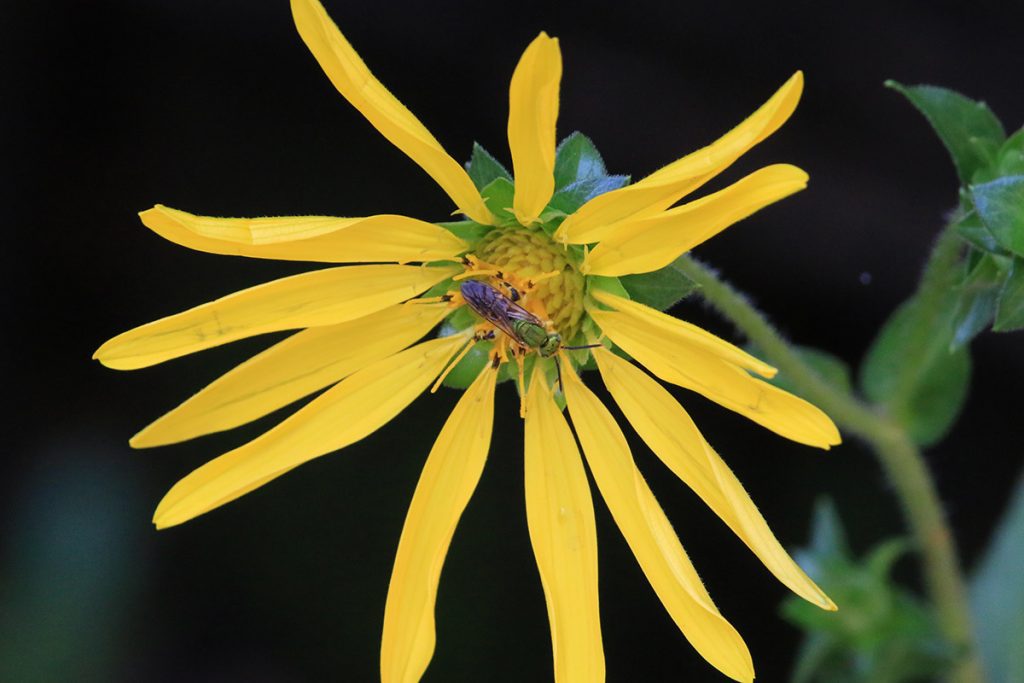
This is the last male brown-winged sweat bee I see in 2020. Over the last couple of years, I’ve witnessed the seasonal rhythm of this animal, and can say that with it’s disappearance, we’re on our way to Fall.
I started seeing the females in June. These were the year’s mothers. Then, like clockwork, the males showed up in August. The last couple of years, the numbers of males and females exploded over the course of the month, swarming our flower patches. Now, here we are on the first day of September, and they’re all but gone again.
In early November, I will see a female at Fred George Basin Greenway. Like many bees, after their season is over, only next year’s queens are alive. Many have already mated, and carry next year’s nests within them. I found an IFAS page on sweat bees, and it says they’re mostly done in Florida by October. The bee I see in November is more than likely gathering her last nectar before overwintering.
I’m especially happy to see it on this flower. I planted two rosinweed flowers last August, right before a several weeks long rainless stretch. Two waterings a day couldn’t save the plants, at least not the above ground portion. That watering must have helped the roots get established, though, and the plants slowly grew back throughout 2020. Here, finally, we see the plants flowering.
September 3, 2020
Another seasonal indicator in our yard are the late summer flowers. Our Brickellia plants have been productive since they started blooming in late July. They don’t attract swarms like the bee balm or loosestryfe, but they appeal to many of our showier pollinators.
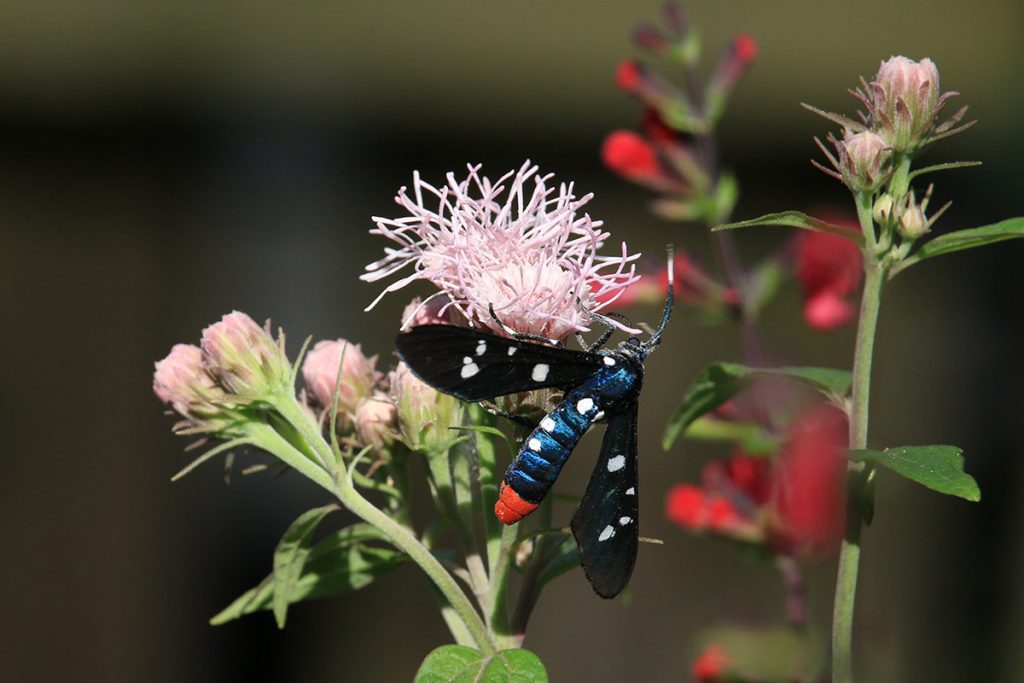
Speaking of showy pollinators… I’m not sure I’ve seen one of these in the yard before. My younger son Xavi was intrigued by this well dressed insect. He demanded that I photograph it and take it into iNaturalist. I was already familiar with the polka-dot wasp moth, but I like going through the process with him. And it’s always fun to log a new species.
I read up on this moth, and I’m a little bit confused. It’s native to the Caribbean, and throughout Florida. But its larval food plant is the Oleander plant, which comes from Europe or Asia. It also eats the exotic invasive air potato. There aren’t polka-dot wasp moths where oleander plants are native, so maybe it used to eat something else? Another reminder of how much we’ve altered the landscape.
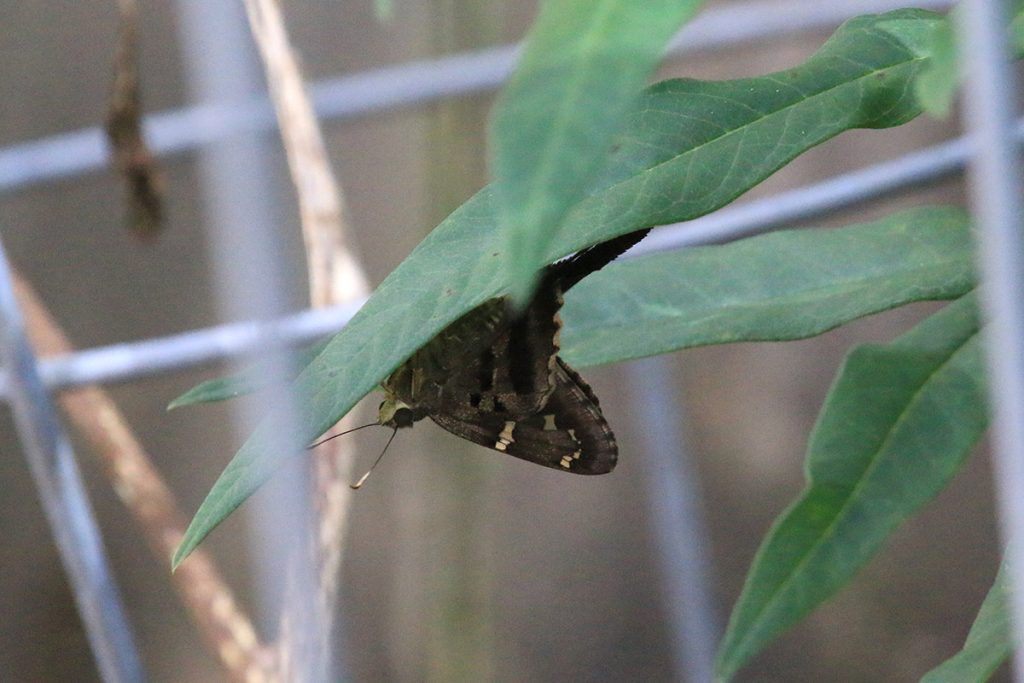
It’s so easy to notice pollinators when they’re visiting flowers. When we walk around our gardens, with no purpose but to observe, we see other behaviors. This is when we see what they do when they’re not eating. Here’s a long-tailed skipper taking a rest.
Not bad for weeds…
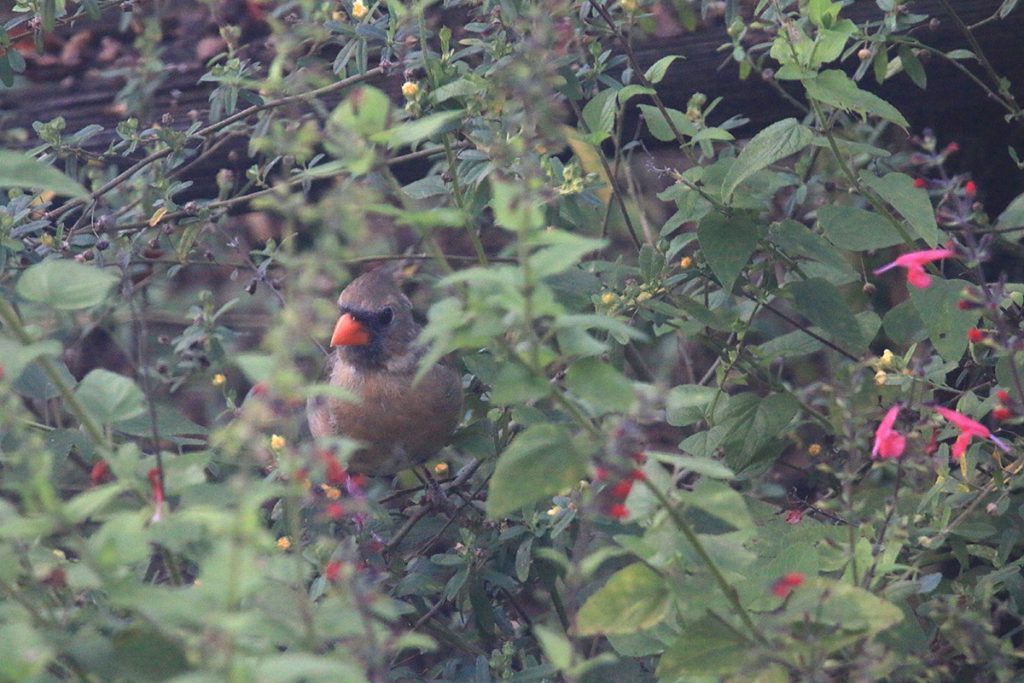
This part of the flower patch, made up of fanpetals and red sage, is popular with birds. Last year, cardinals pecking at fanpetal buds got me curious about they were eating. I was hoping to find checkered skipper butterfly caterpillars. They host on fanpetals, and the adult butterflies are common in our yard. It was something else, and I’ve since seen stink bugs and other plant eaters on these little shrubs.
I know I write about fanpetals a lot. Here’s my almost monthly plug for this plant. You’re not likely to see them for sale at a nursery, but they are native, and they’ll just kind of show up in your yard. Pollinators like the flowers, and the leaves are full of food for birds.
September 4, 2020
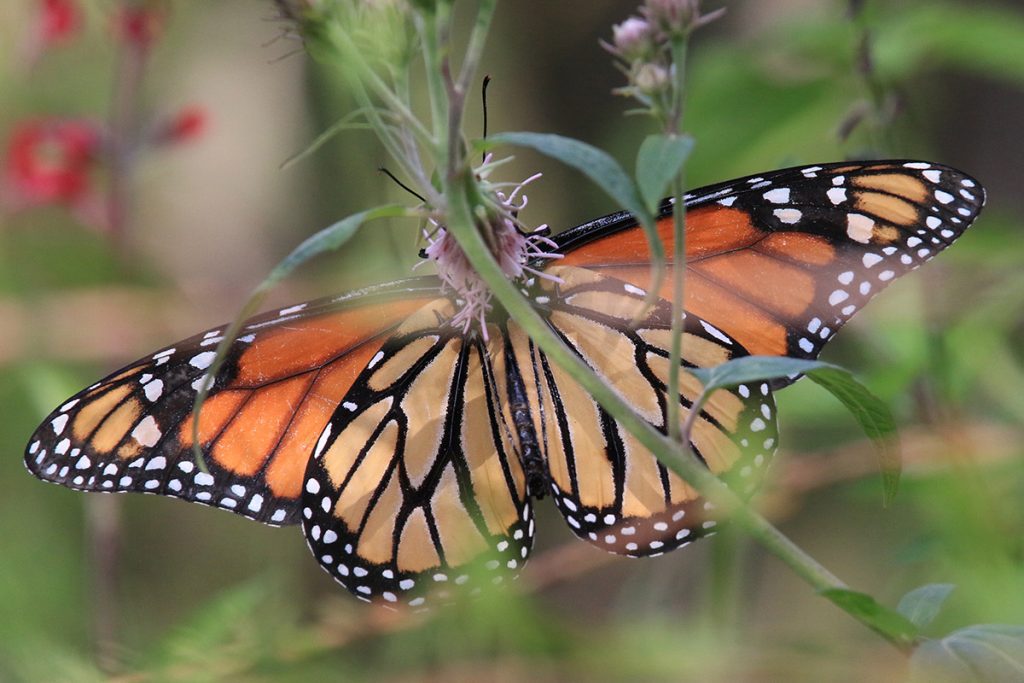
Again, the Brickellia is where all the fancy pollinators go. And again in 2020, I wonder, is this monarch in our yard to lay eggs on the milkweed, or did it just eclose from a hidden chrysalis?
We’ve had much fewer caterpillars this year, and they’ve been disappearing before they grow very large. Sometimes, I don’t know we have caterpillars until I see those big ones. I’ve not been seeing their chrysalides, but I do see shiny new monarchs from time to time, a couple of weeks after the cats have gone.
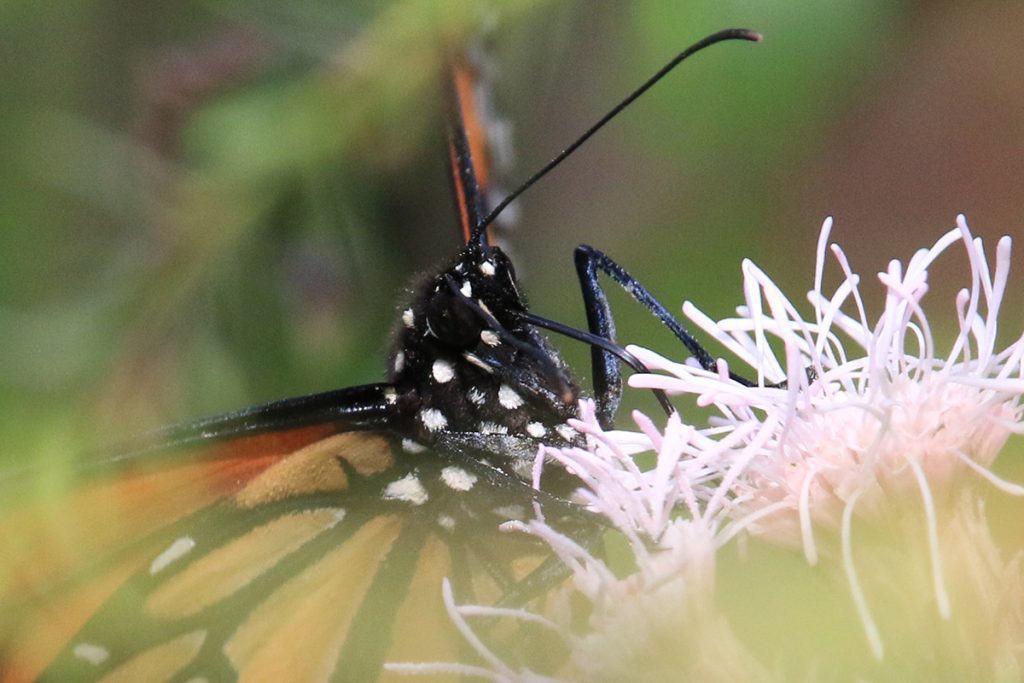
Anyhow, this one stayed a while to eat. It has young looking wings; maybe it’s starving after not eating in its chrysalis these last couple of weeks?
September 5, 2020
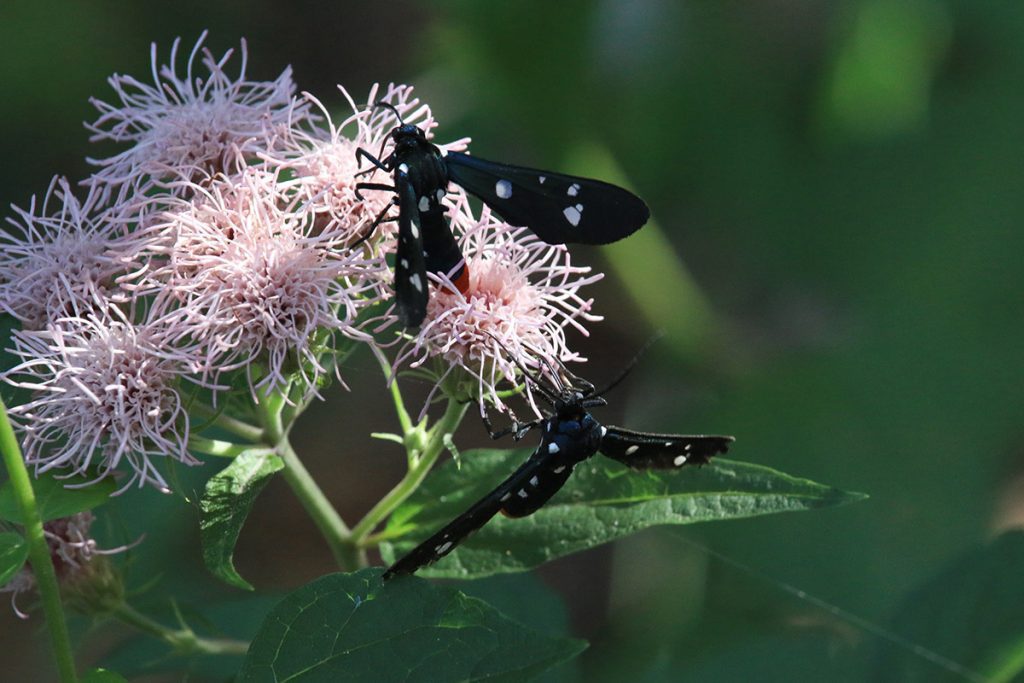

And now we have two. The days of crazy swarms around our flowers may be over, but we’re now in the days of large, showy pollinators.
September 6, 2020, a branch fell on the driveway
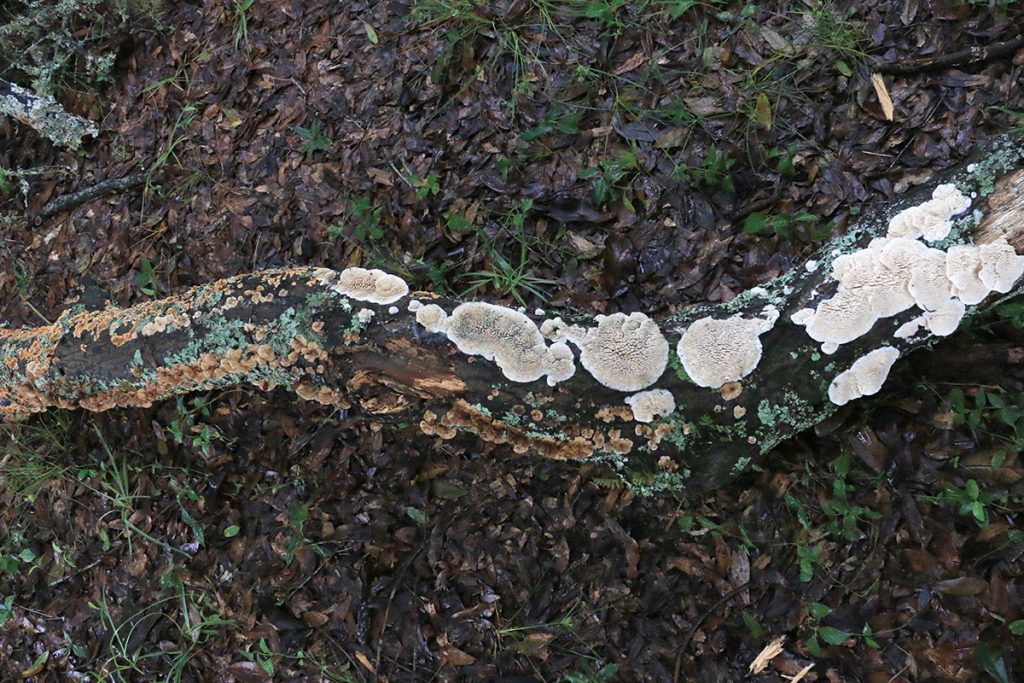

Fungi feed on dead wood, aiding decomposition. Looking at how many mushrooms were growing on this branch, it’s no mystery why it snapped off and fell in our driveway. I have a lot to learn about mushrooms, and iNaturalist doesn’t seem to have mycologists checking observations in our area. So these are my best guesses as to what we see here. Either way, I think this is a pretty neat branch.
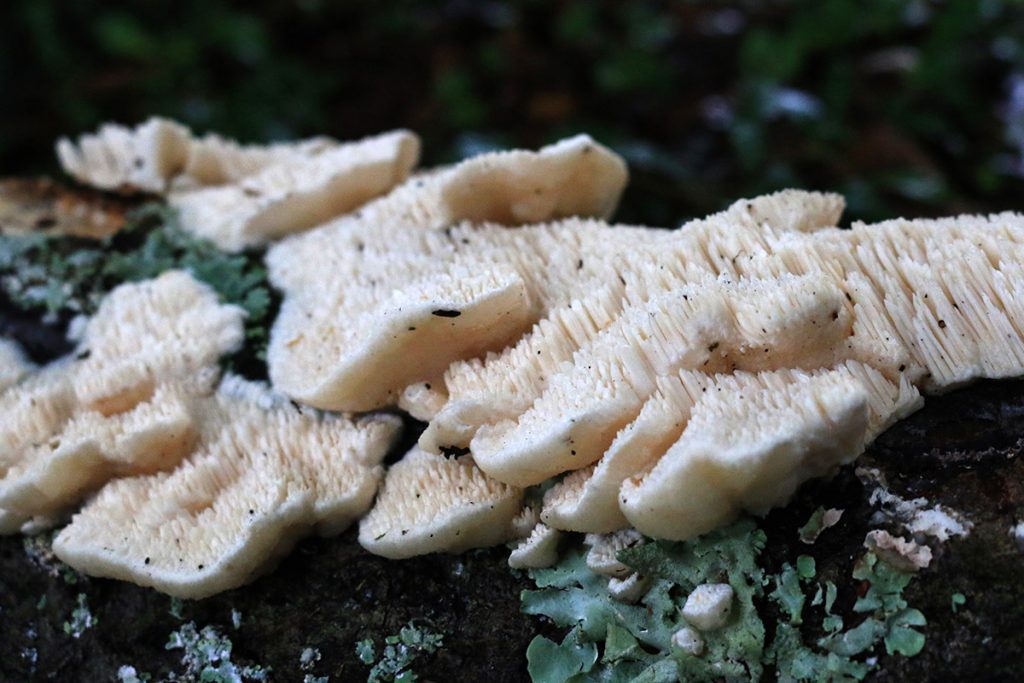

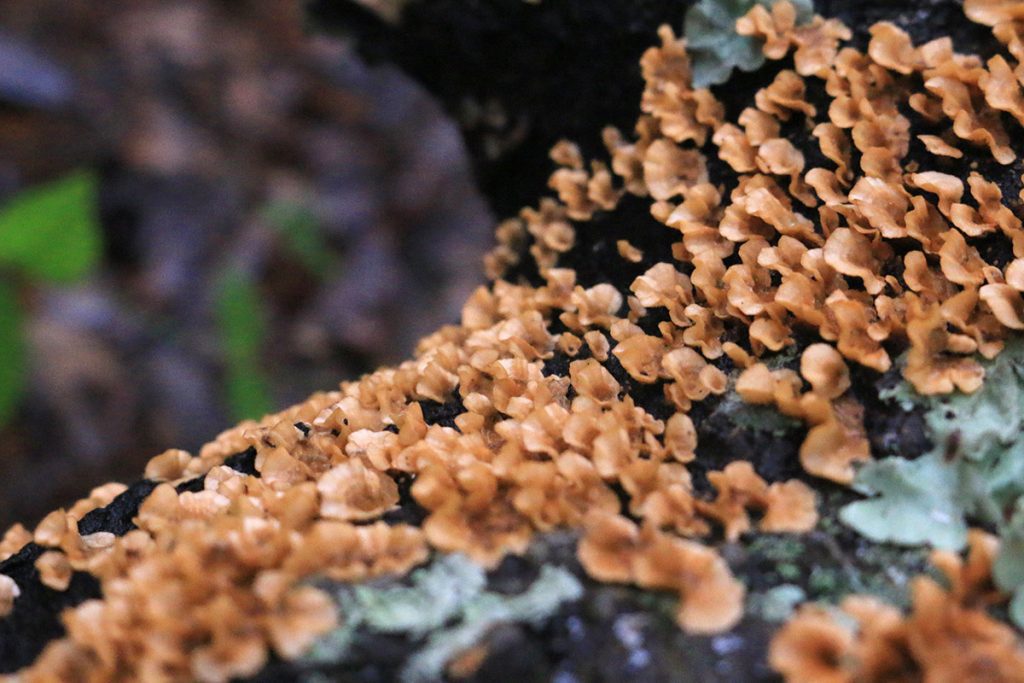

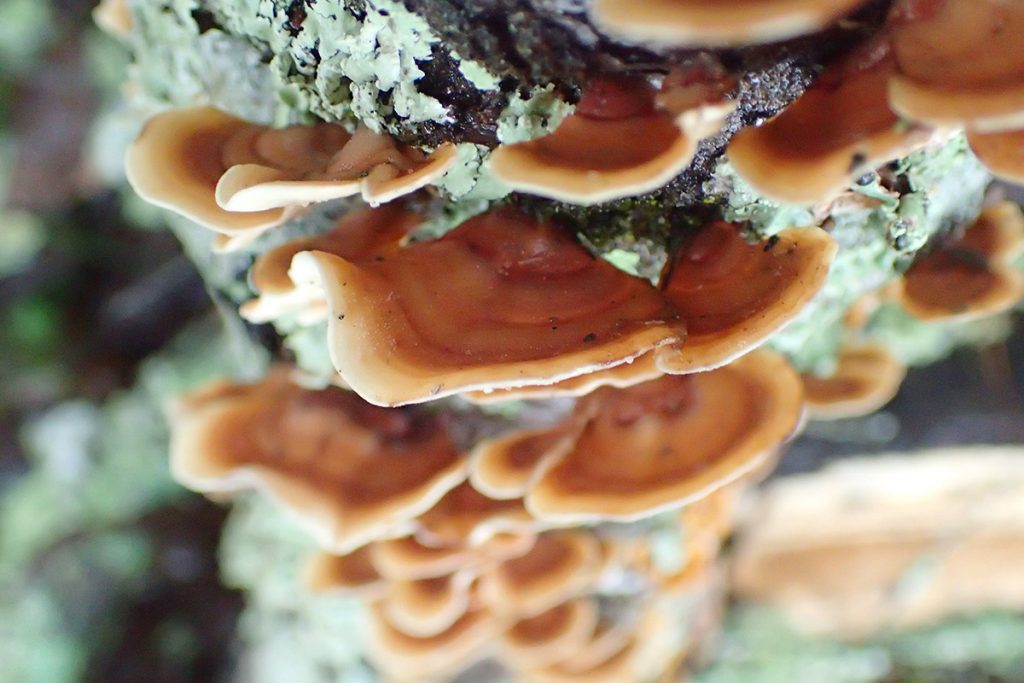

There are three members of the Stereum genus with the common name false turkey tail (in our area, at least). I think this is one of them.
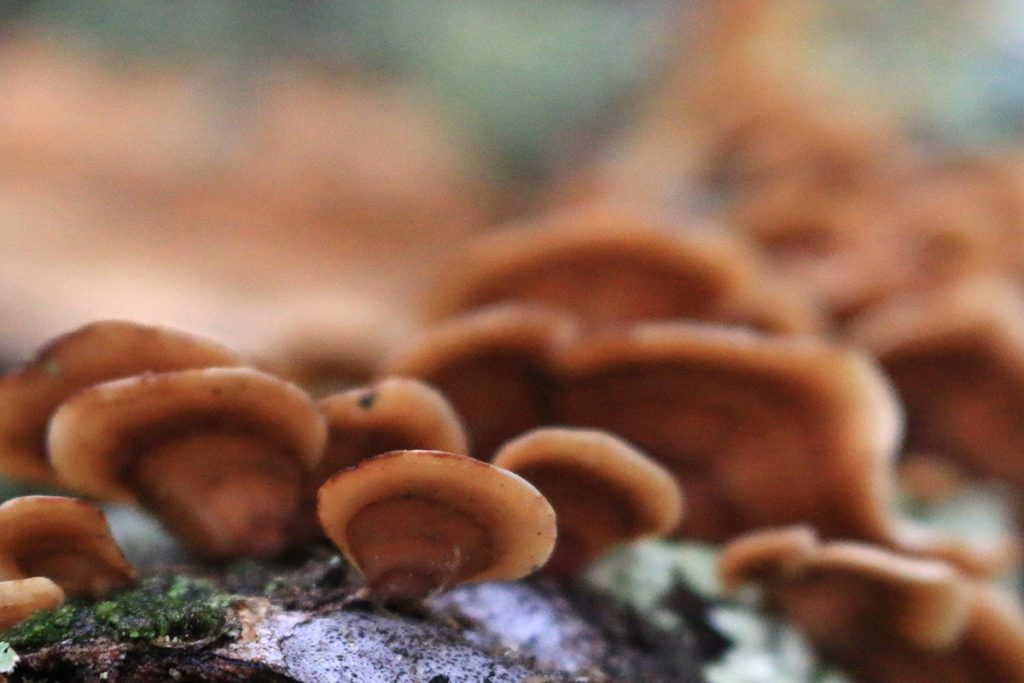

September 7, 2020
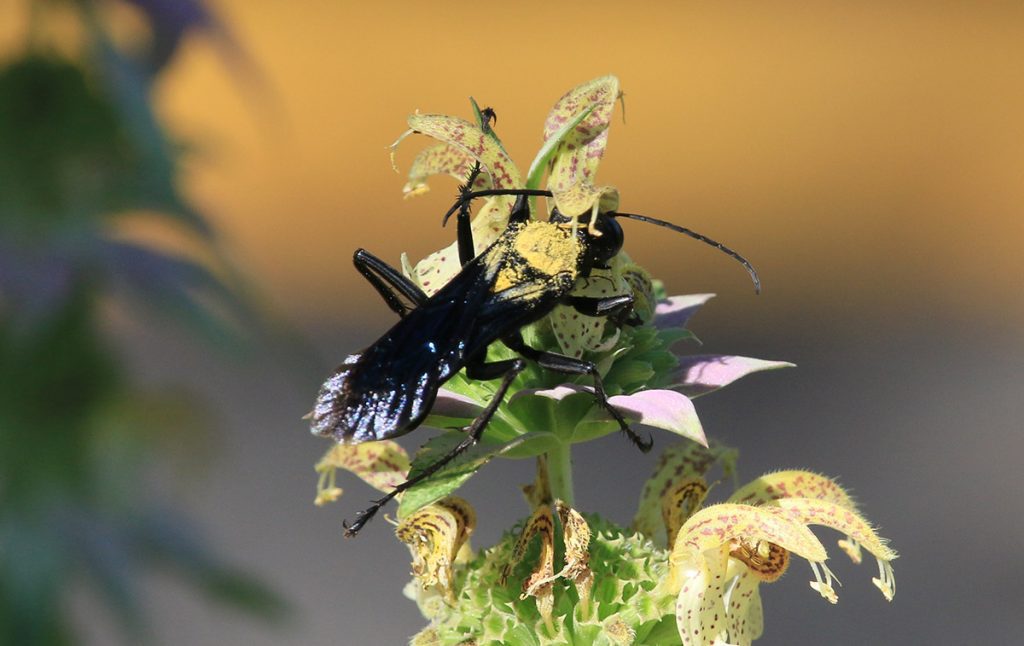

The bee balm (aka dotted horsemint) has mostly gone to seed. Most of the wasps that swarmed around the bee balm patch have gone, as have all of the brown-winged striped sweat bees. But we’re not entirely done. We can see from the pollen on its back that this great black digger wasp has been making the most of the remaining flowers.
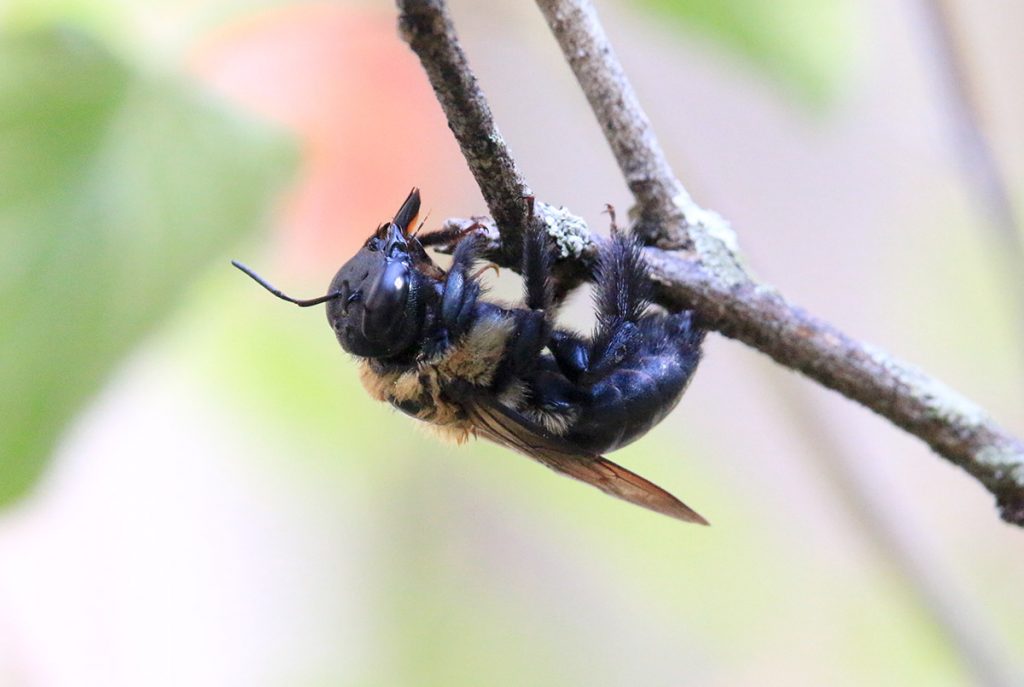

Another resting pollinator. Now I can lean in and get a closer look at this fuzzy little guy or gal.
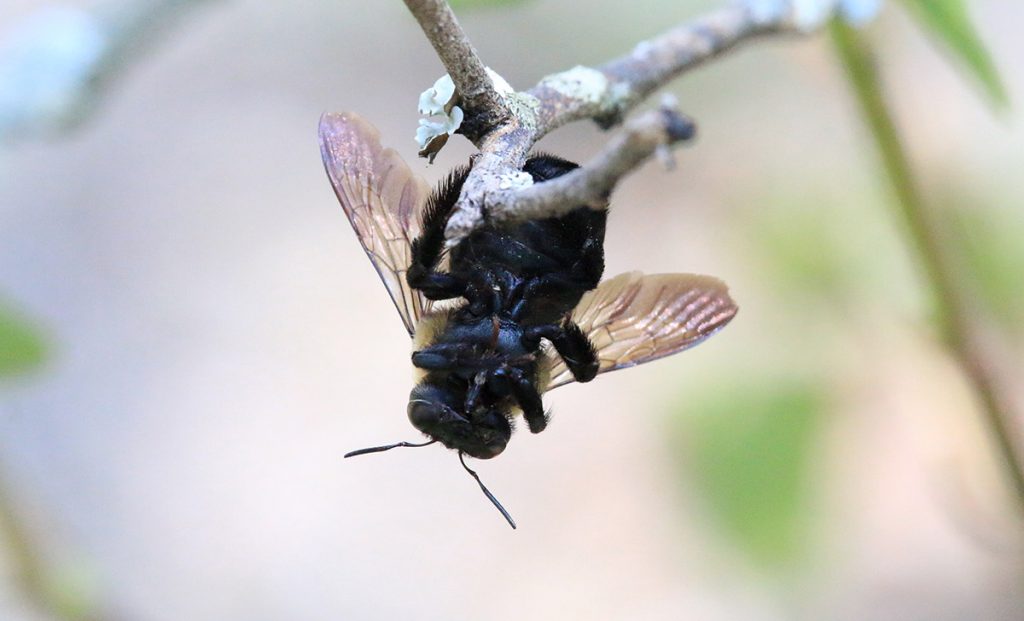

September 8, 2020
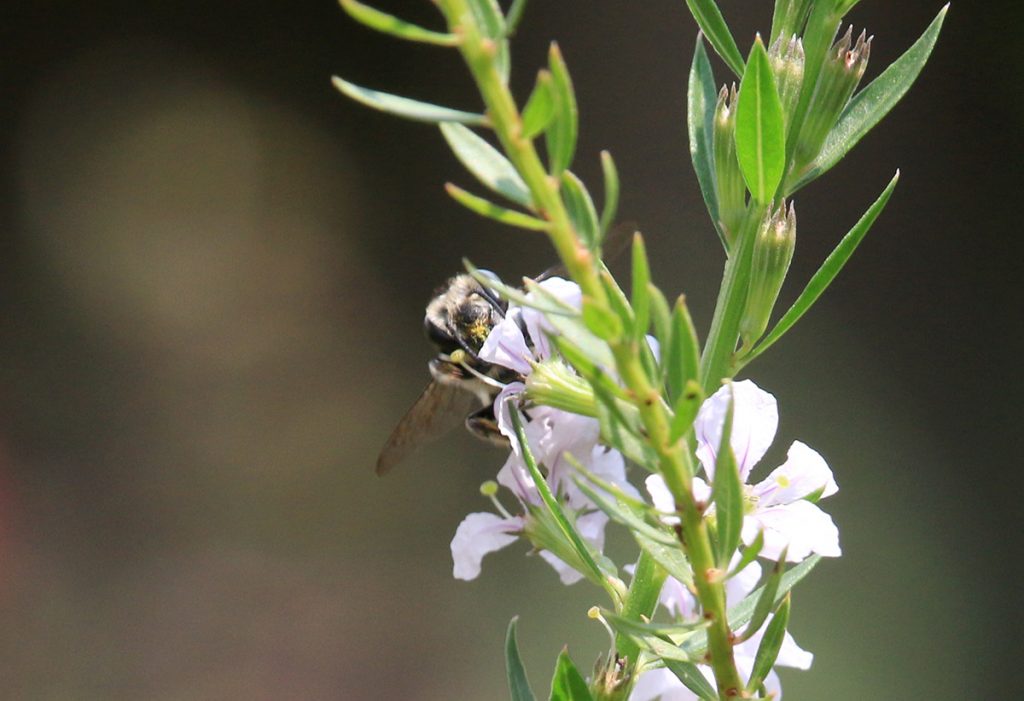

Earlier in the year, we had a carpenter bee mimic leafcutter bee in the yard. And then in July, I became familiar with a few different leafcutter species at Elinor Klapp-Phipps Park. I hadn’t known much about them before this year, but now I recognize their squished looking abdomens, and faces built for slicing leaves to line their nests. When it was busier in the flower patch, I’d occasionally see a leafcutter mixed in with the many other bees. Today was less busy, but this bee wasn’t staying put for very long. This is the only image it allowed me to take.
September 21, 2020
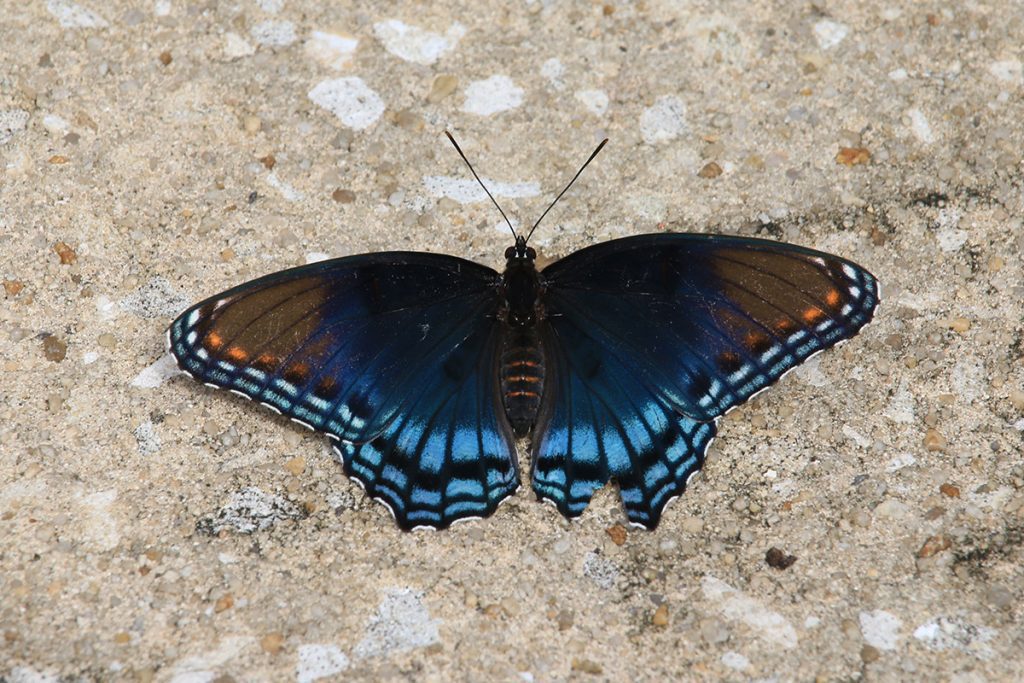

Another resting pollinator. This red-spotted purple made a cooperative photo subject. It soon flew off in search for food, but not where I expected.
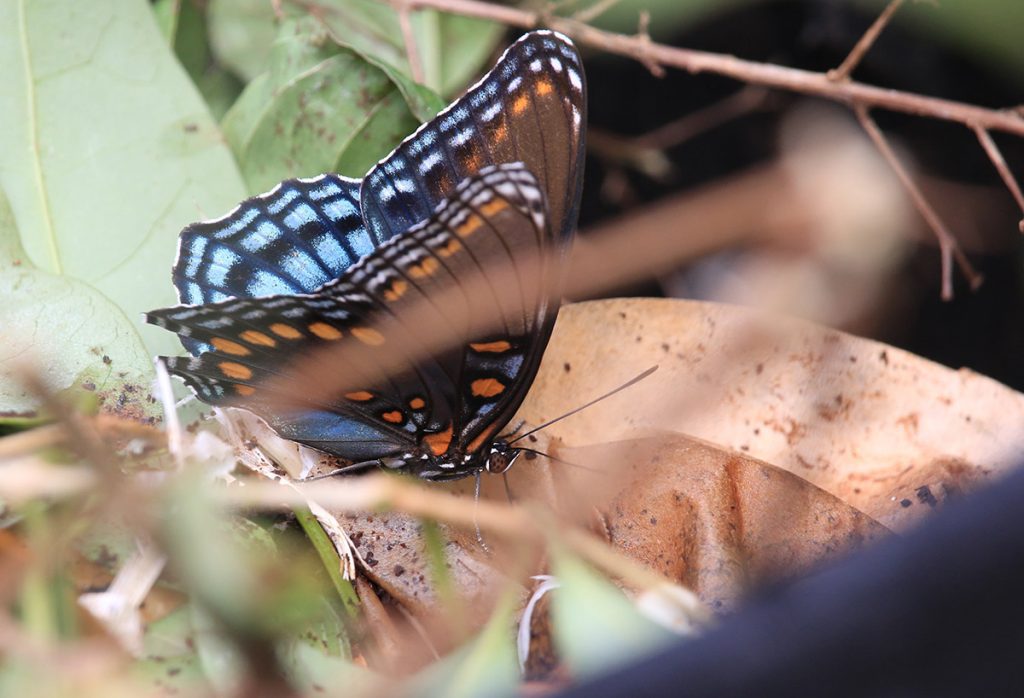

I’ve seen where people leave rotting bananas out to attract butterflies. I didn’t want to scare this one off, so I didn’t get close enough to see what it was sticking its proboscis into. Was it after sugar? Salt? I never see this species on our flowers, but something in our discarded fruits and veggies called to it.
September 23, 2020
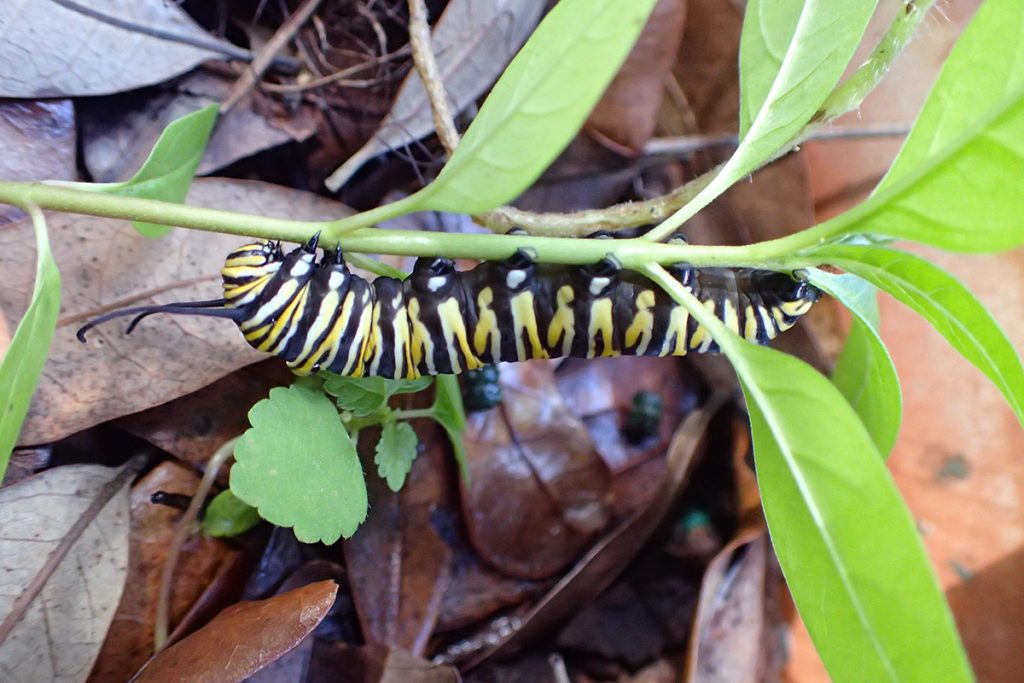

You may notice I didn’t take any photos for a couple of weeks. I was busy working on the WFSU Age of Nature project, and wasn’t taking those ten minute garden photography breaks. That monarch I saw at the beginning of the month- maybe it was here to lay eggs after all? It would take about that long to lay eggs, have them hatch and grow to about this size.
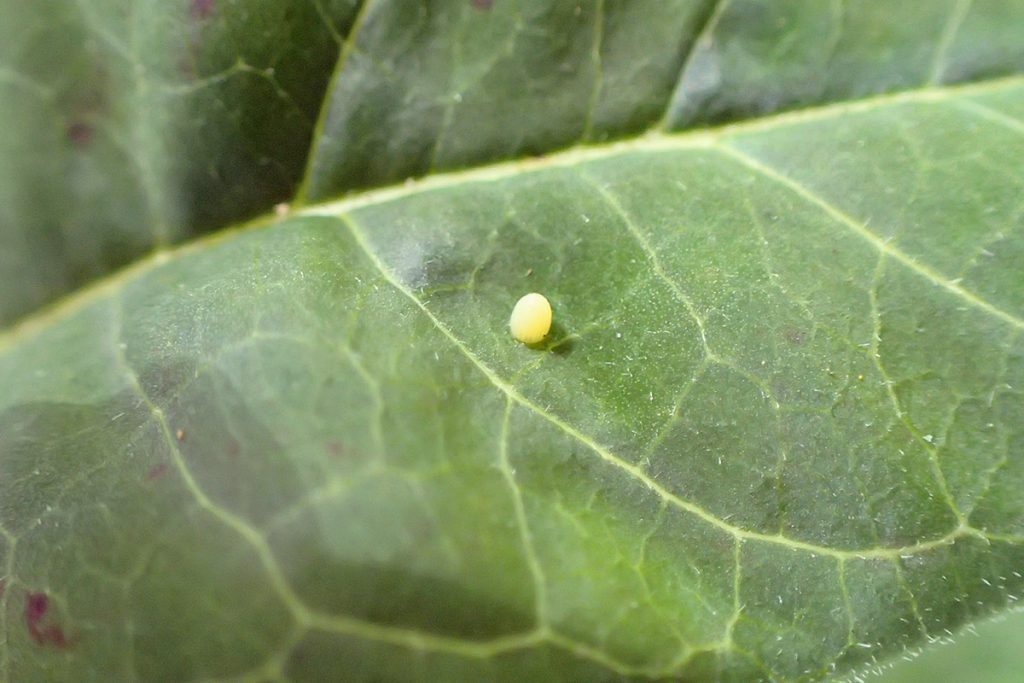

Looking at the leaves, I find at least one egg.
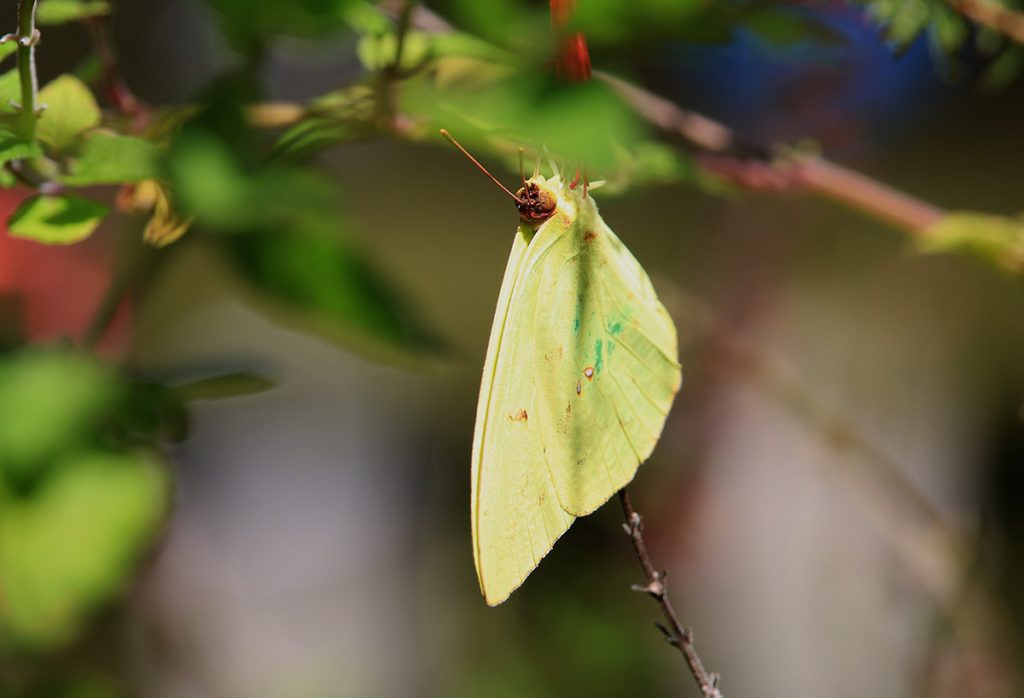

Here’s a species of butterfly that we see year round. But in the fall, cloudless sulfurs from colder areas migrate down as well. This is one of the few species of butterfly that overwinter as adults. In other species, adults lay one last brood before they die. Eggs and/ or chrysalides keep next year’s butterflies secure until spring. For butterflies with short flying seasons, chrysalides have to stay intact, not getting eaten or trampled, for months. The Frosted Elfin’s chrysalides are in the leaf litter by mid-May, but the butterflies won’t emerge until the following February.
Species like cloudless sulfurs and monarchs, they have to go where it’s warm for the winter. I often see sulfurs resting like this in December and January. If you’re sharp eyed, you might see them hiding among yellowed leaves.
September 24, 2020
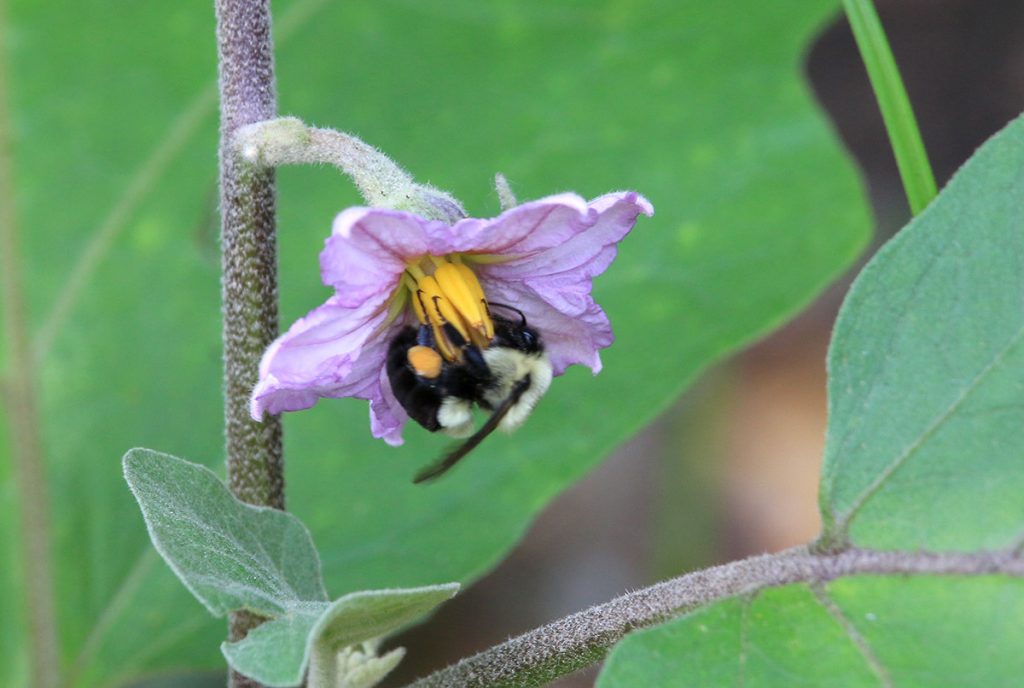

Earlier in the year, the only bees I saw in the yard were honey bees, bumblebees, and carpenter bees. This is what I’m seeing now in the yard, even if I’m seeing the other bee species out in “capital N” Nature. I’m lucky to have these remaining bees for the last of our summer food plants.
September 26, 2020
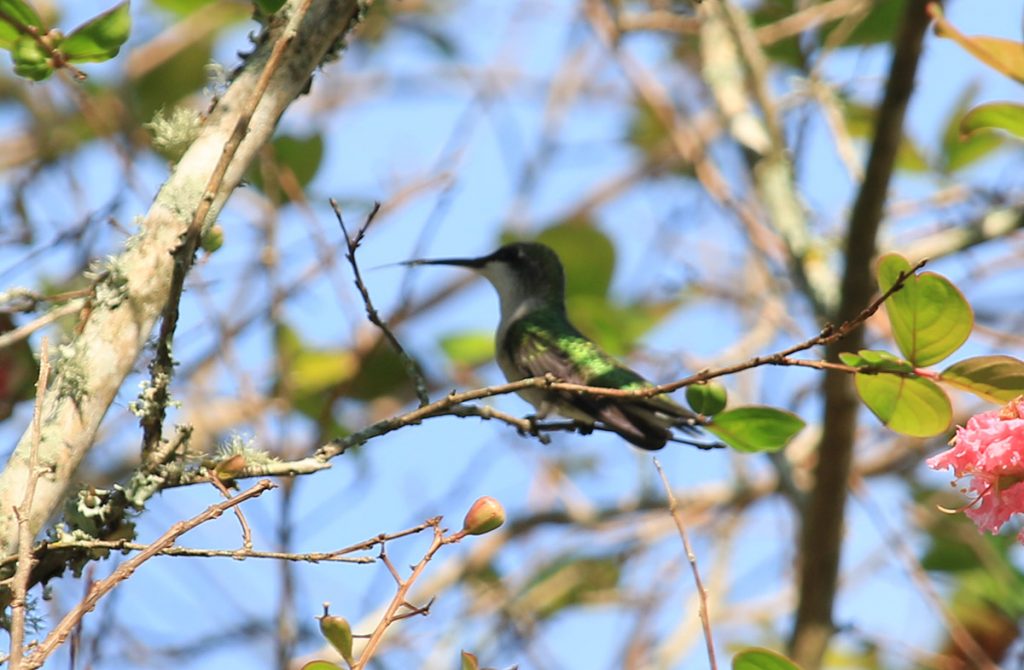

I only ever see hummingbirds in our yard for a few moments before they notice me. It’s not a large yard, and there’s no way to sneak up slowly on the flowers they like.
Today started like that. But then, the hummingbird kept coming back to that sweet red salvia. And perching on crepe myrtle branches for a few moments. These were the photos I was able to take.
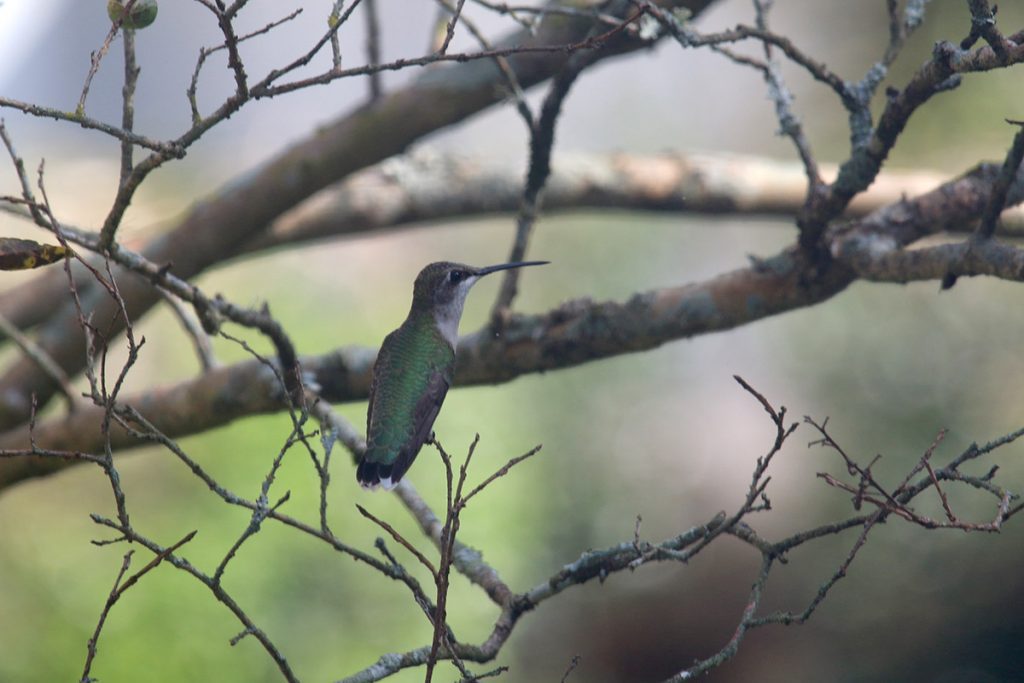

So why is this female bird hanging around?
September 27, 2020
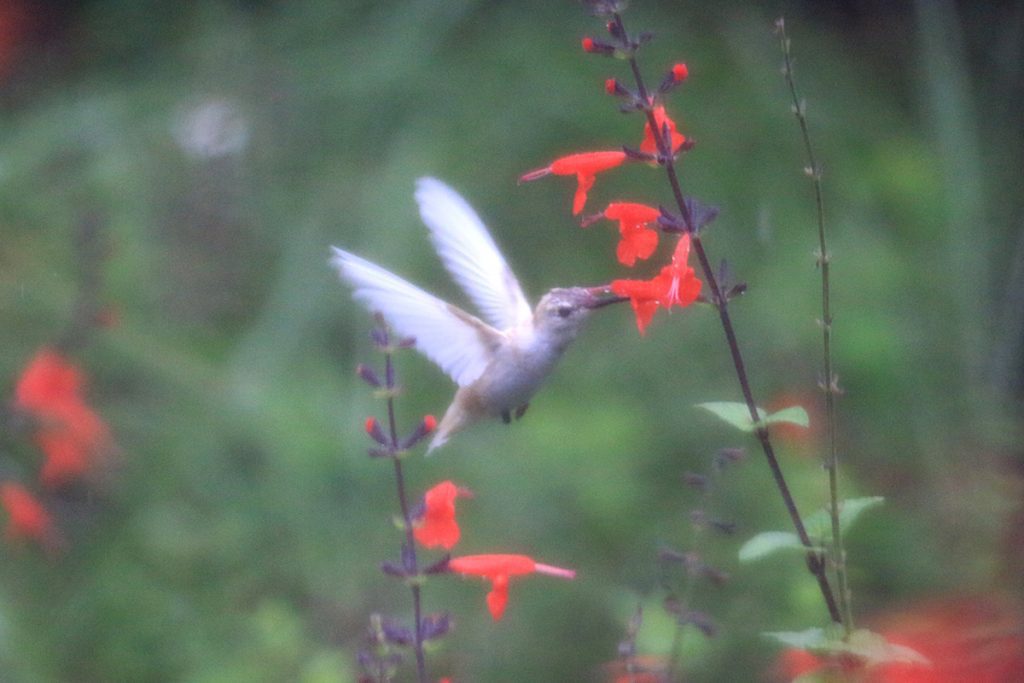

Today, there were two hummingbirds, and one was pale. I think this is a newly fledged bird. Yesterday, mom was busy around the flowers, gathering a lot of nectar to bring back to the nest. Today, the child joins the mother.
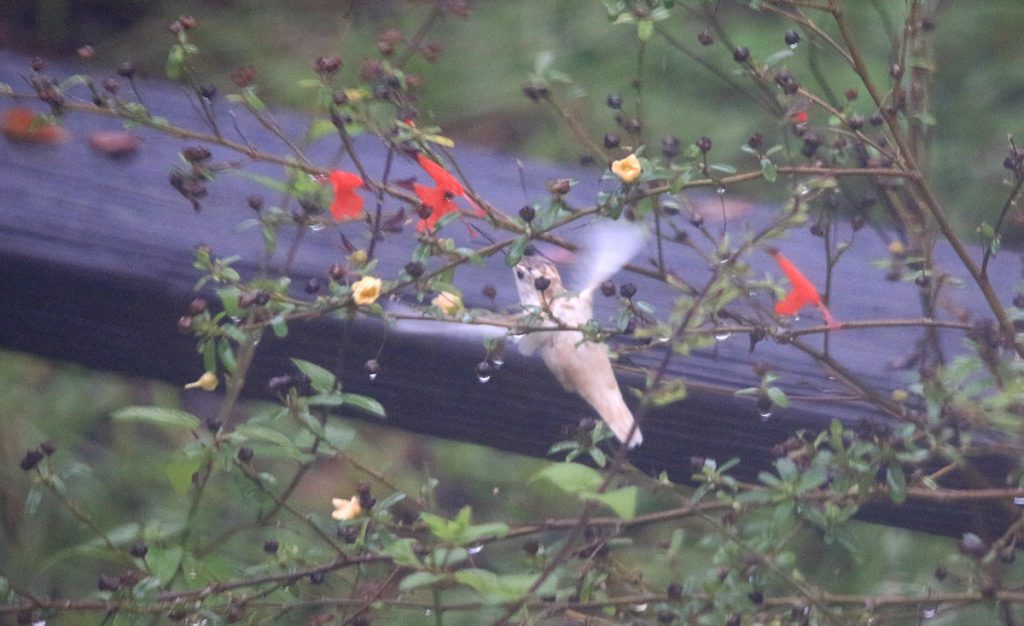

These birds are still shy, and I didn’t want to spook a young bird by repeatedly trying to sneak up on it with a camera. So these photos are shot through the window. I need to install a bird window like the one at Birdsong Nature Center.
In a year where I’ve been neglecting the bird feeder, we’ve still seen brown thrashers, Carolina wrens, and cardinals foraging among the weedy, overgrown parts of the yard. Hummingbirds are here for the nectar; those other birds are here for the insects eating those plants.
September 30, 2020
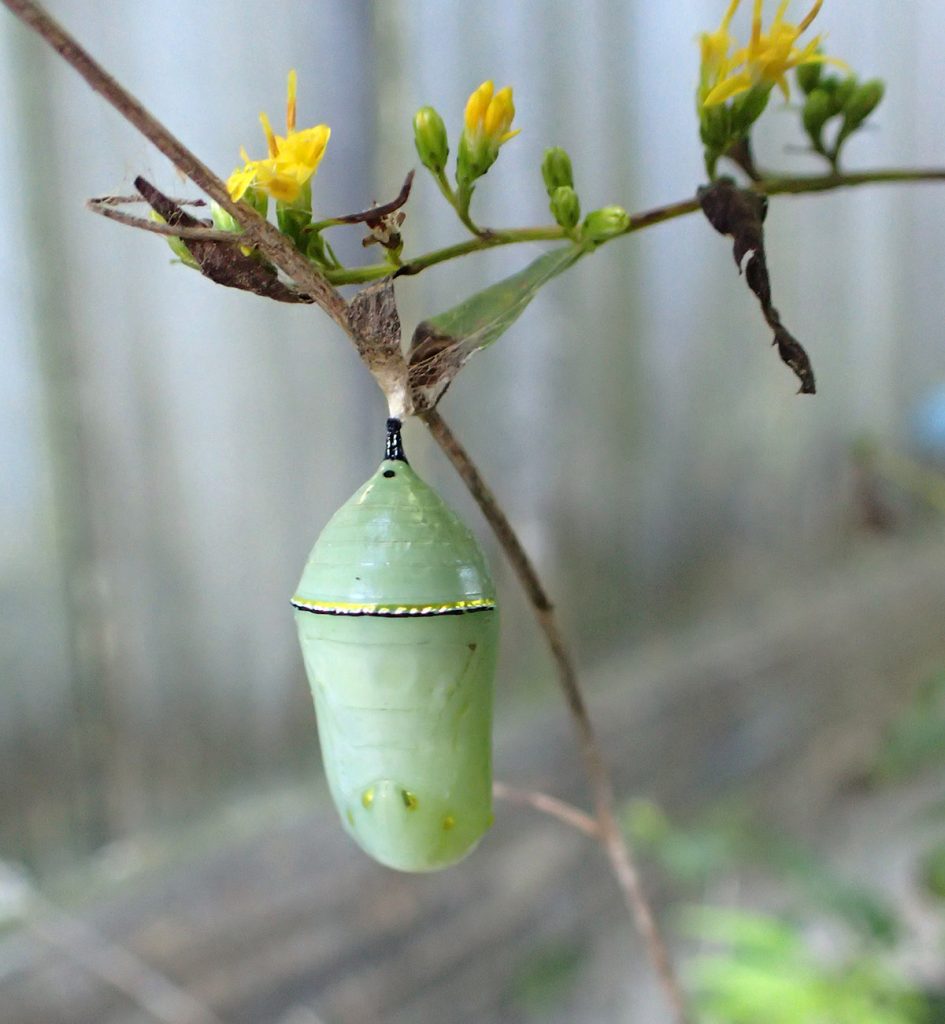

It’s a nice day out, and so we have lunch outside. I sit facing a few potted plants by the fence, and notice that the goldenrod is starting to bloom. And, then, what’s this under these new goldenrod flowers?
Monarchs breed on their northern migration, but in September, the migration south to Mexico is underway. In October and November, I’ve seen southern migrating monarchs clustered on goldenrod behind sand dunes near the coast, loading up before taking off over the Gulf of Mexico. Of course, there are always stragglers. We’ve often had late season chrysalides, and some of those may be from a permanent population here in Florida.
Anyhow this is the first intact chrysalis I’ve seen in the yard this year.
October 2, 2020
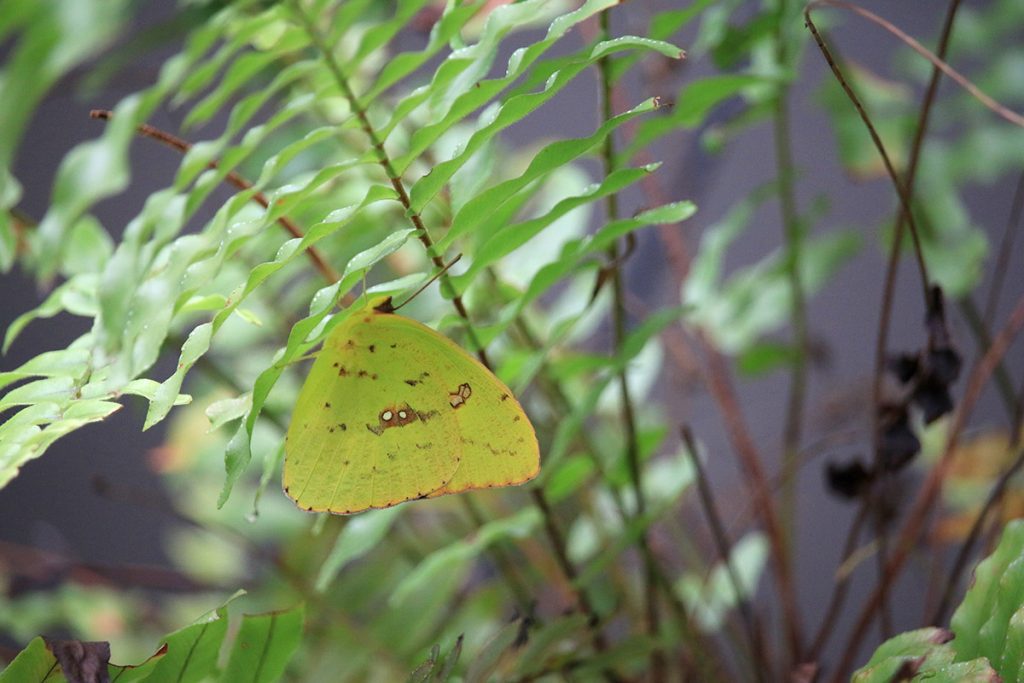

Another resting sulfur.
October 7, 2020
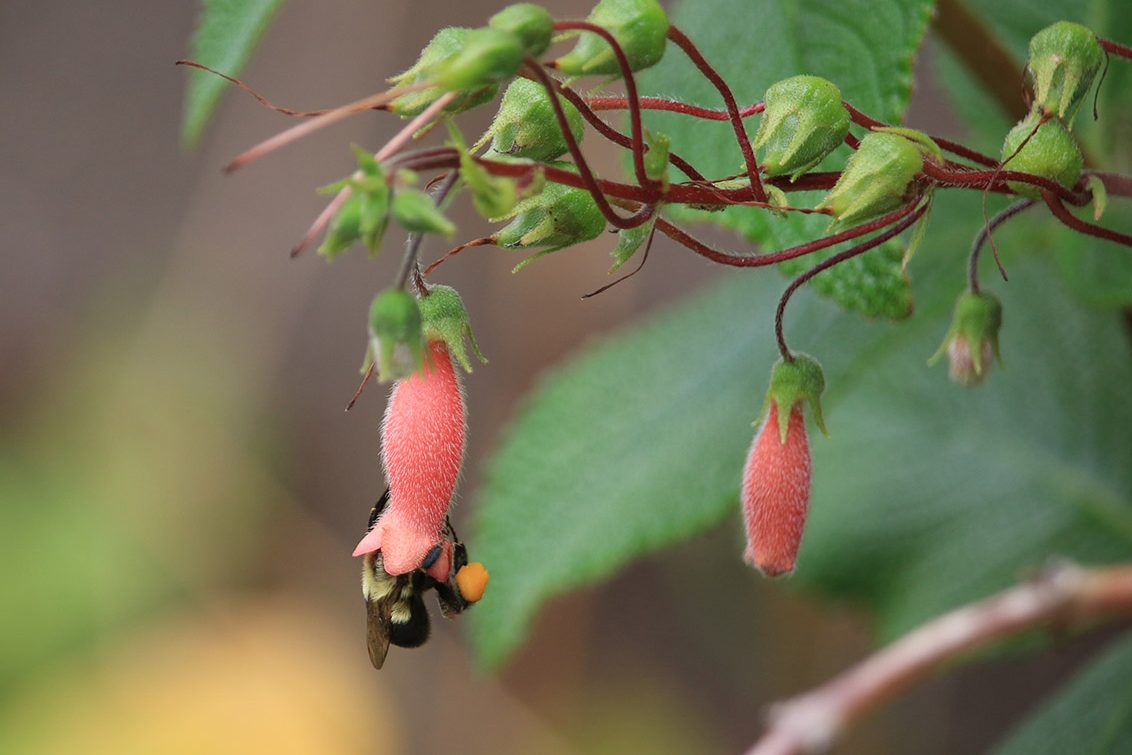

As we transition to the fall wildflower season, I’m seeing our bumblebees try out new plants. This, I believe, is Sinningia Sellovii. I bought it years ago at the Birdsong Old Timey Plant Sale because of a sign that said it would attract hummingbirds. This is a plant native to South America, and it only occasionally draws attention from pollinators.
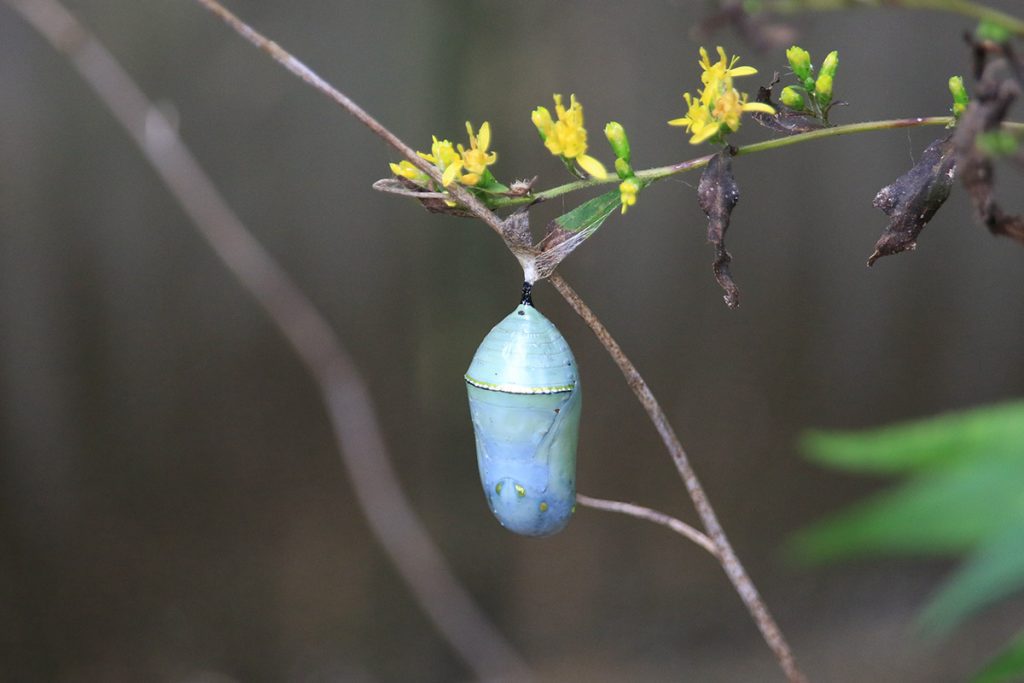

I’ve also seen the bumblebees try the goldenrod. Over here, the monarch chrysalis has been hanging for over a week now, and it is becoming transparent.
October 8, 2020


And there it is!
This has been our quietest year since we started raising monarchs. It’s been a down year for caterpillars in general. Despite multiple host plant options, we didn’t see any black swallowtails. We had two different giant swallowtails, but one at a time instead of the usual two or three.
I’m not necessarily concerned about it. We had heavy pollinator activity, and a wide diversity of plant eaters and predators. It could be that in our home ecosystem, this year, conditions were less inviting to mother butterflies. Or it could be any number of factors in the surrounding neighborhood, or regional trends. It’ll be interesting to see how many caterpillars we get next year, which will my fourth documenting the yard on the blog.
If we have two down years in a row, I’ll start to worry.
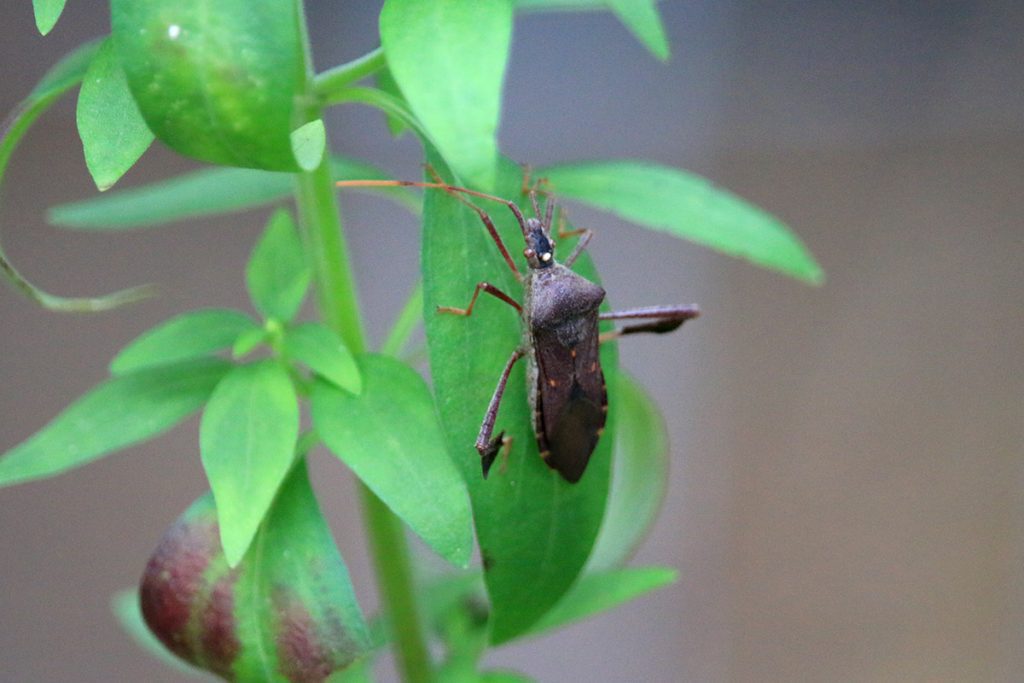

Another fall bloomer has grown and is starting to bud. I was looking at our blue curls when I found this leaf footed bug hanging out.
October 9, 2020
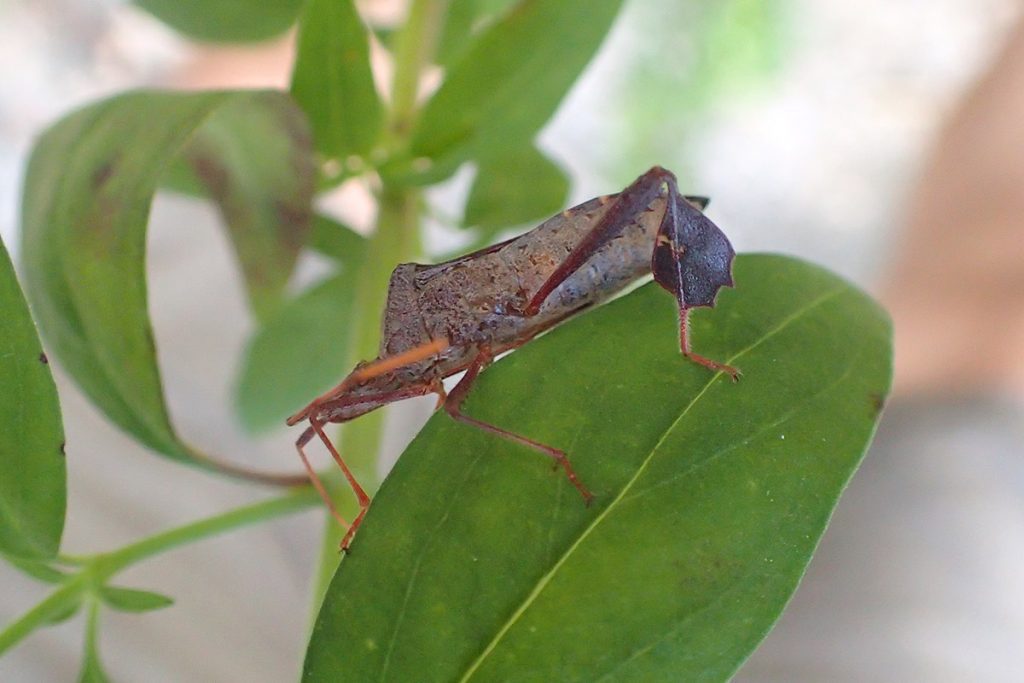

Today I got closer and can see this insects cool hind legs.
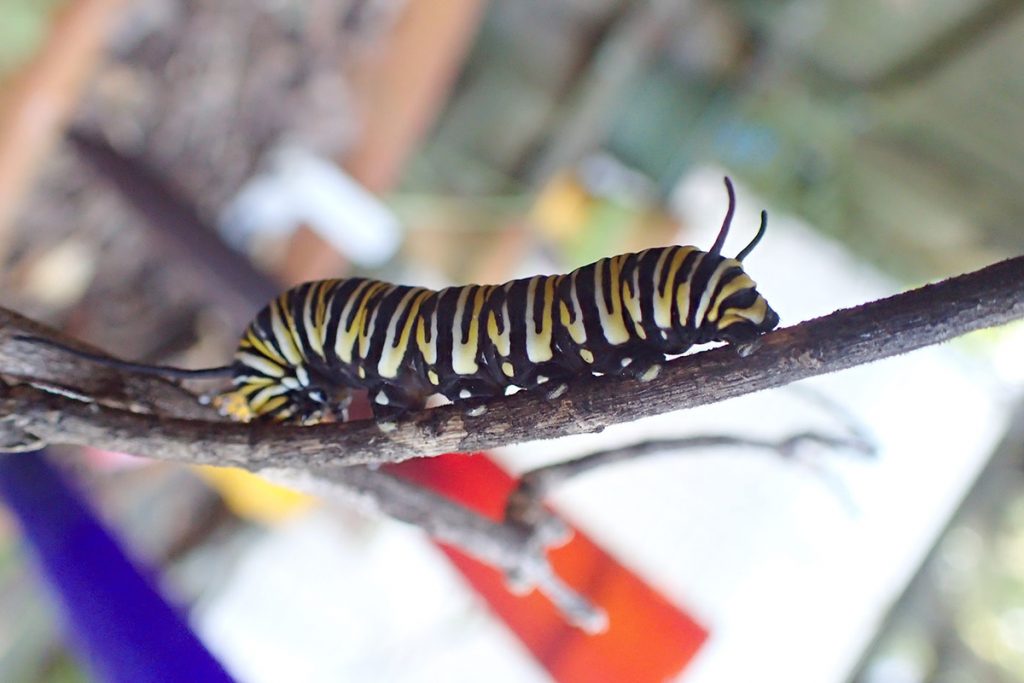

And another monarch caterpillar, fifth instar. This is the first and last I see of this one, in a year where monarch chrysalides have remained well hidden in the yard.
October 10, 2020
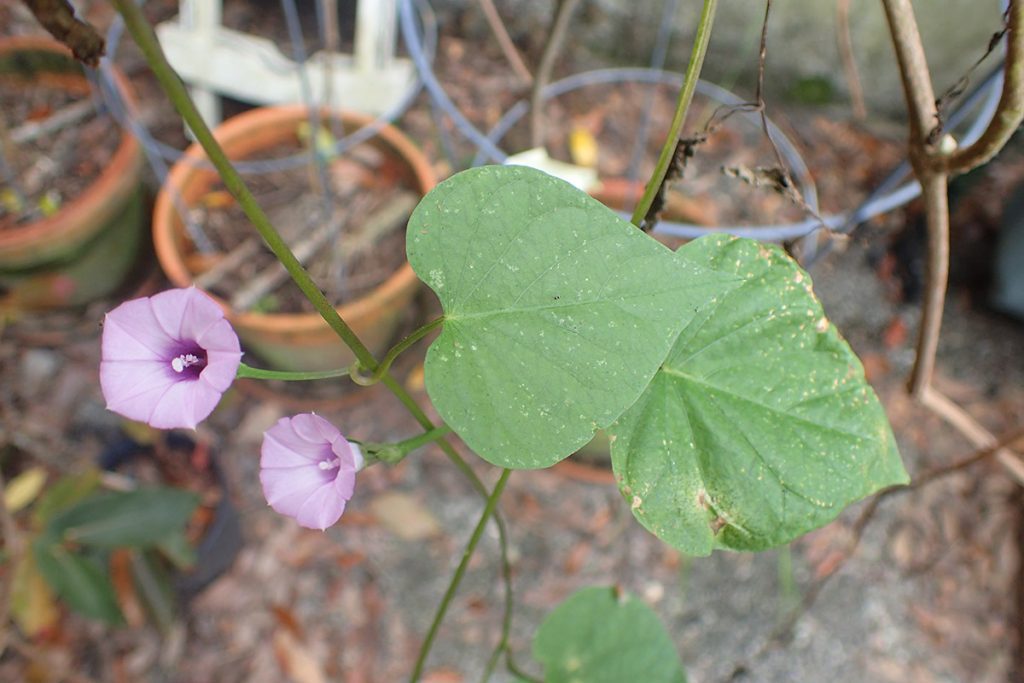

A few morning glory vines popped in the yard over the summer. It took them a while to flower, so I had to wait for an ID. It turns out this is tievine.
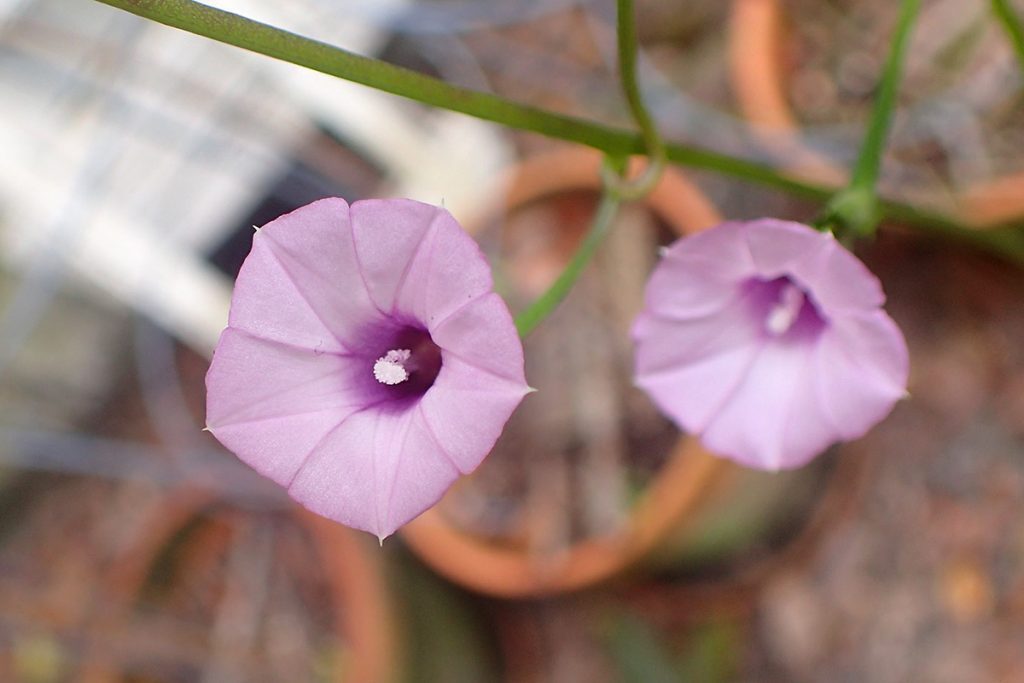

Here’s a closer look at the flowers.
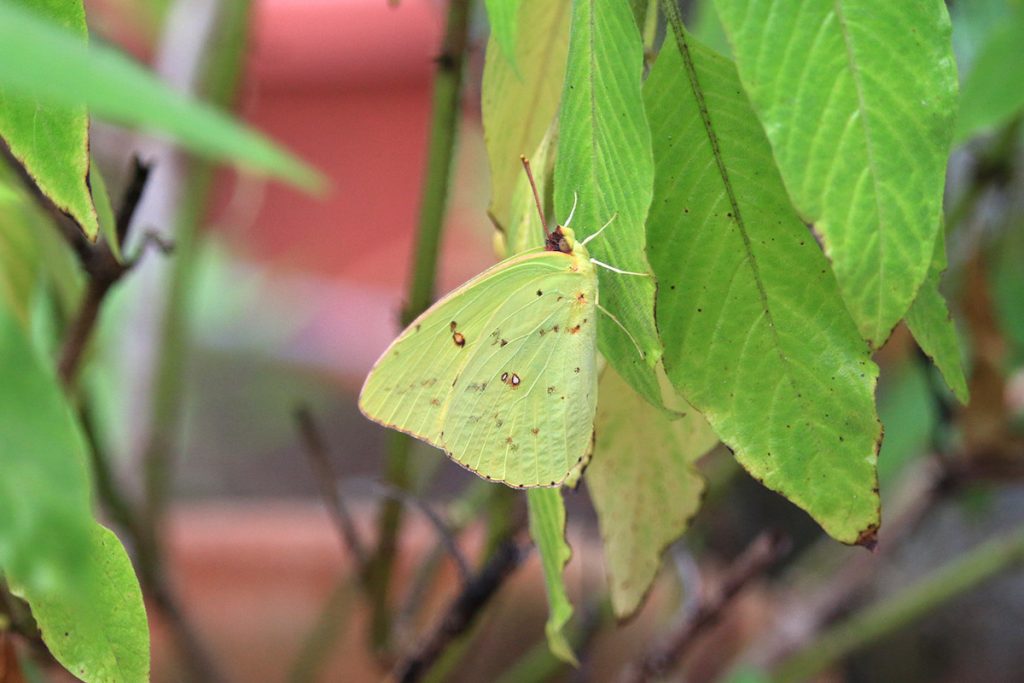

The boys and I watched this sulfur for a while. When we passed by the pentas plant, we scared it out. It seemed choosy about finding a new place to hang, finally settling on some drooping leaves. Look at those brown spots on the cloudless sulfur’s wings, that look like wear on a yellow leaf. A sensible adaptation for a butterfly that lives through the winter as an adult.
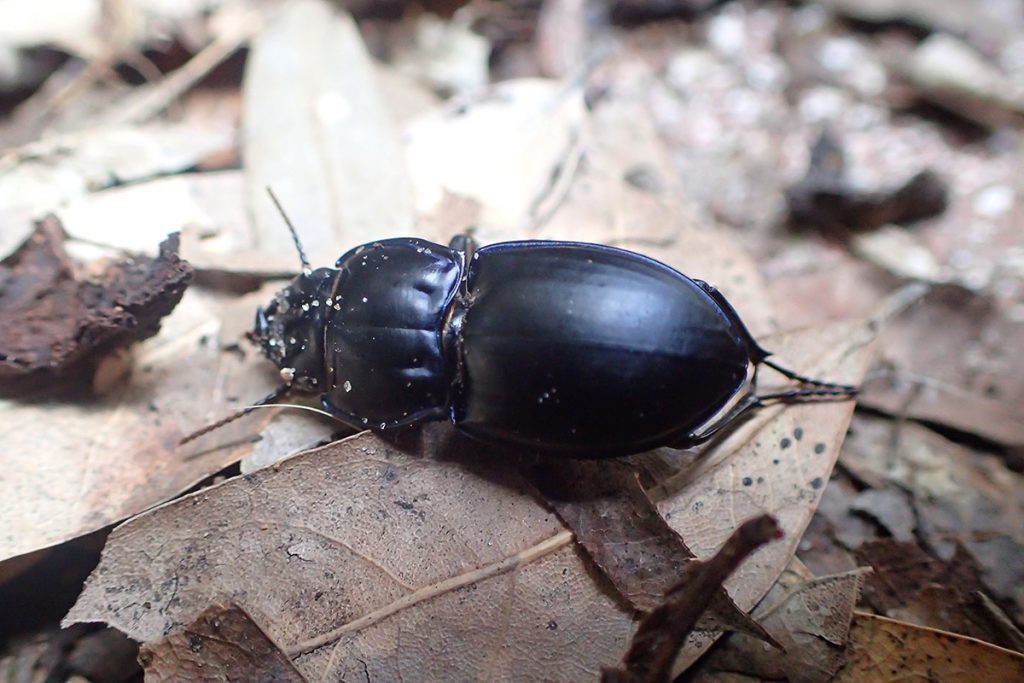

I found this dead beetle in some leaf litter. While I didn’t find any information about this specific species, ground beetles are mostly predators. And predatory insects, who keep plant eating insects in check, are a good thing.
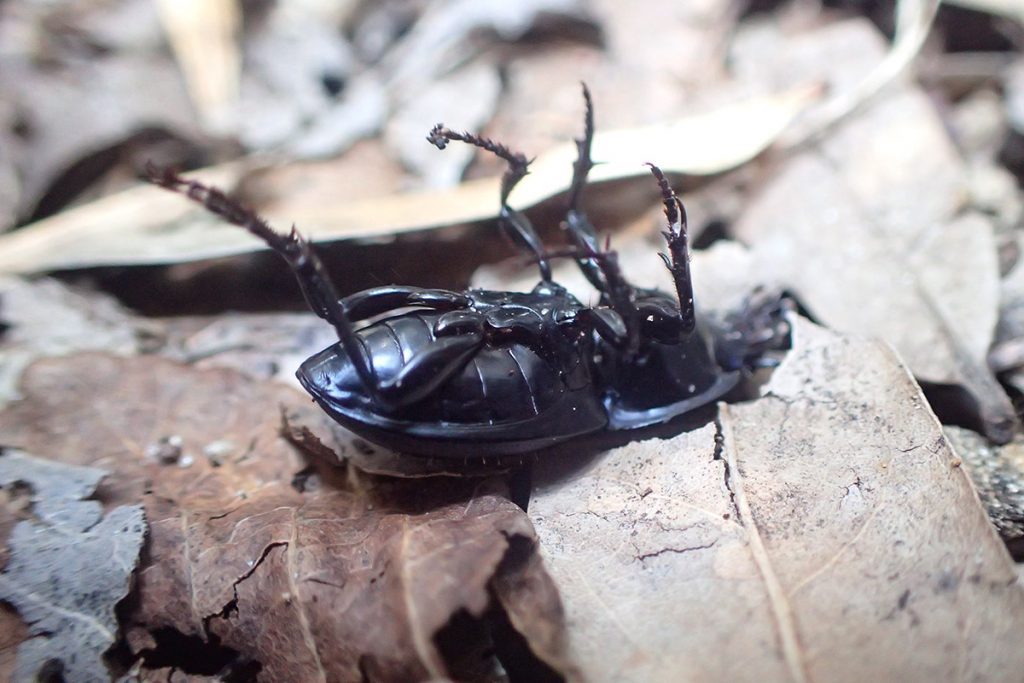

I flipped it over for another view. It’s good to photograph plants and animals from different perspectives, and with closeups of different features, before uploading to iNaturalist.
October 11, 2020
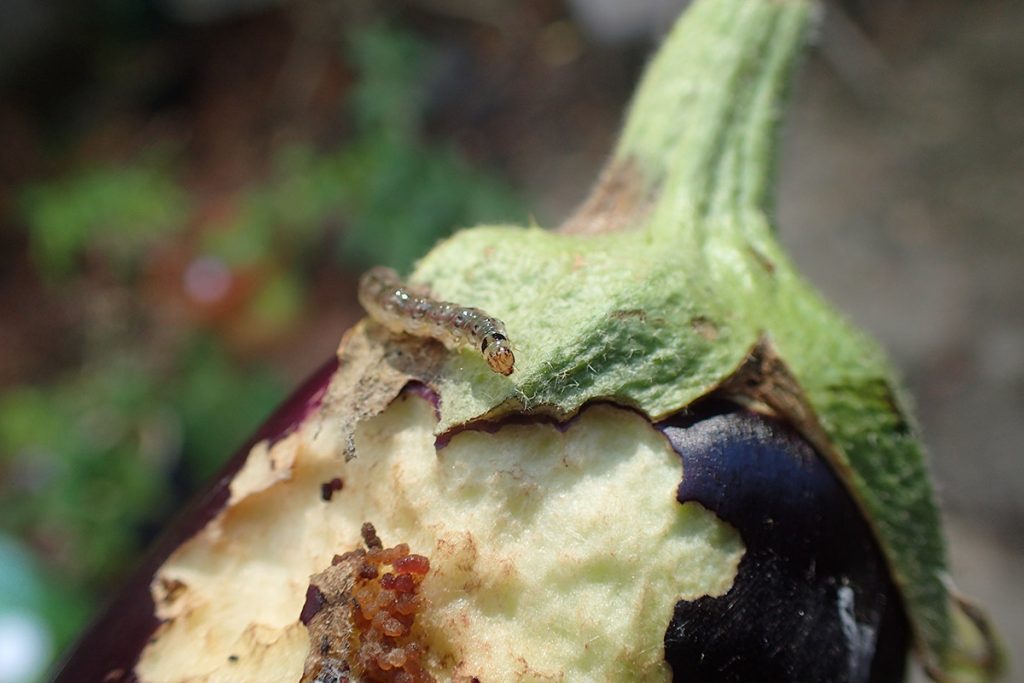

After some Googling and reading, I think this is a leaf roller, the larvae of Tortix moths. They are garden pests, and while they mostly cause leaf damage, they can go after fruit as well. This is an eggplant I brought in from the garden. It sat on a counter for a couple of days before one day, Amy noticed this damage. And the caterpillar that emerged from it.
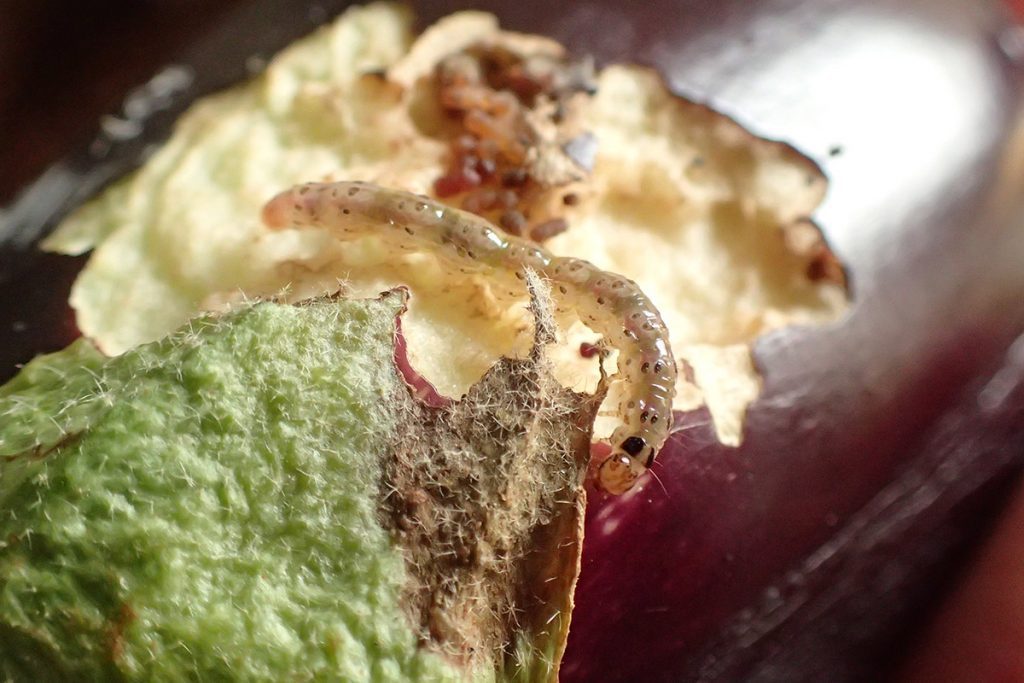

Here’s a closer look. I’m not a fan.
October 22, 2020
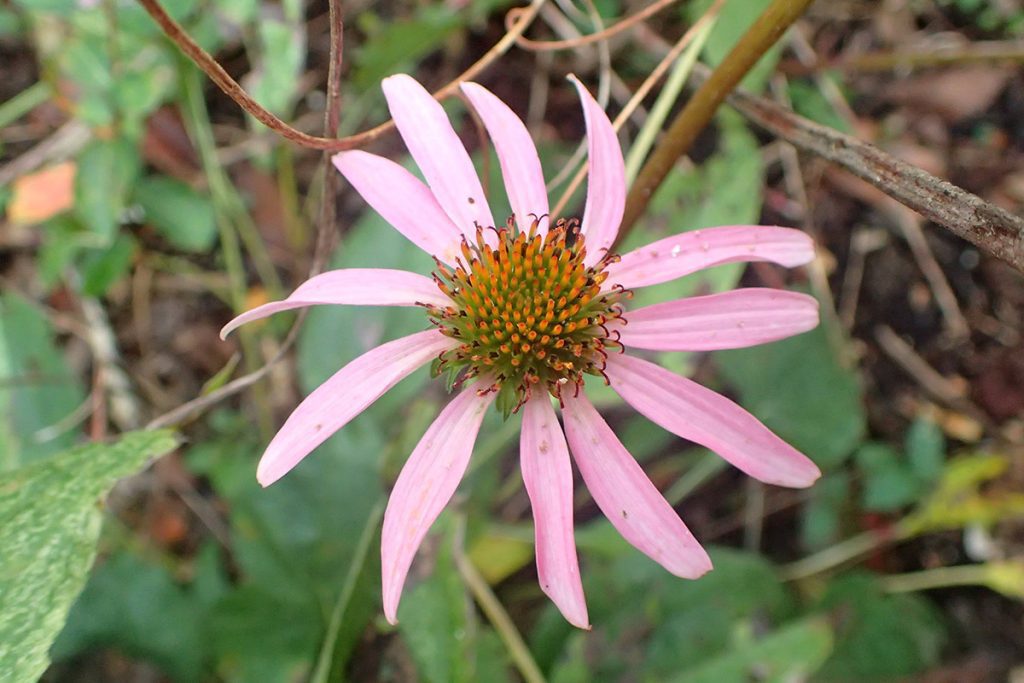

Our flowers are transitioning to fall, but today I found one plant acting unseasonably- this coneflower. The rest of our coneflowers went to seed weeks ago, so it was a surprise to see this new splash of pink in the flower patch.
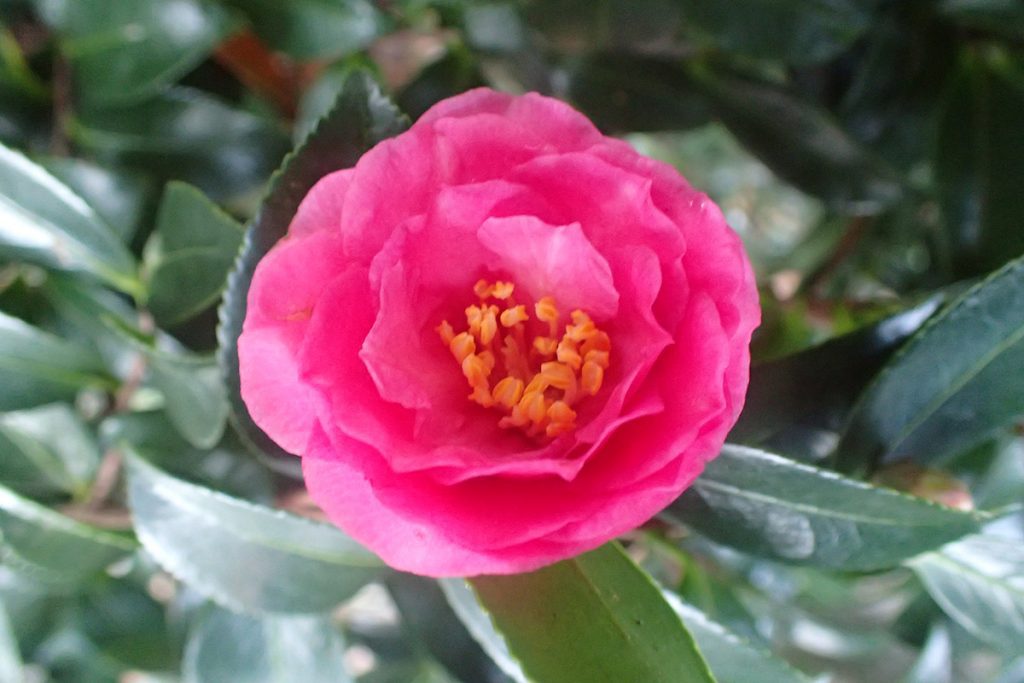

Different camellia species bloom at different times, and last year our Sasanqua camellias didn’t bloom until December. So this had seemed like an early bloom to me, but then I checked the 2018 Backyard Blog. They started in October then as well. As we get closer to wrapping 2020, I’m liking that I have multiple years of records of blooms and insect appearances.
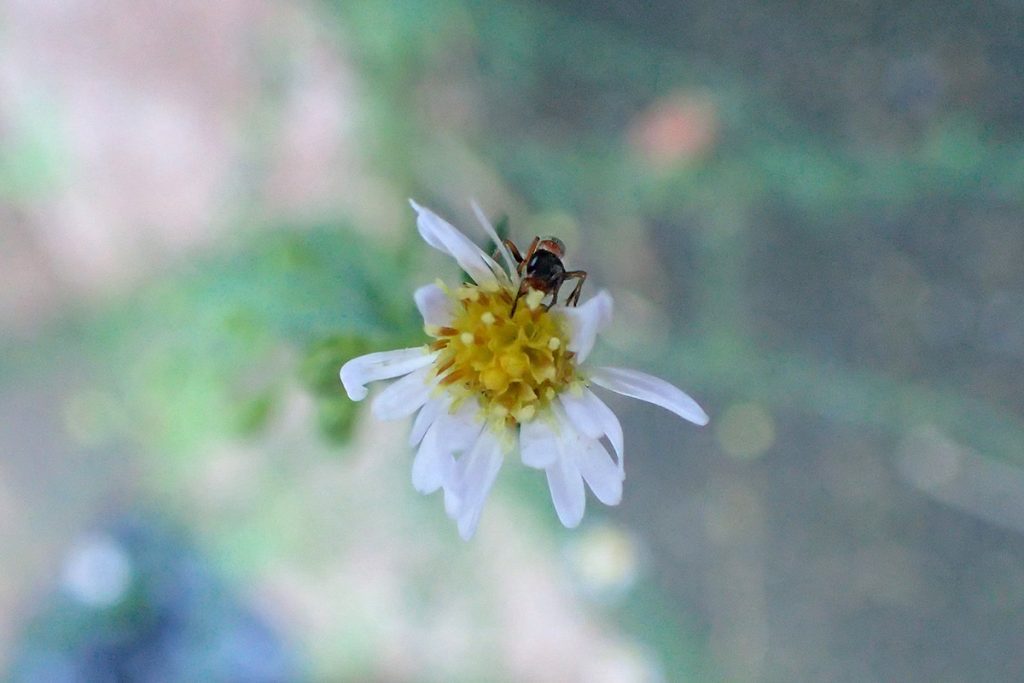

Our little rice button asters are right on schedule. Their spot used to be right where the flower patch is now, and last year, they still grew and bloomed right along the fence behind the salvia, and the loosetryfe, coneflowers, and Brickellia gone to seed. I think they were crowded out from there this year, but have popped up in several other spots.
October 25, 2020
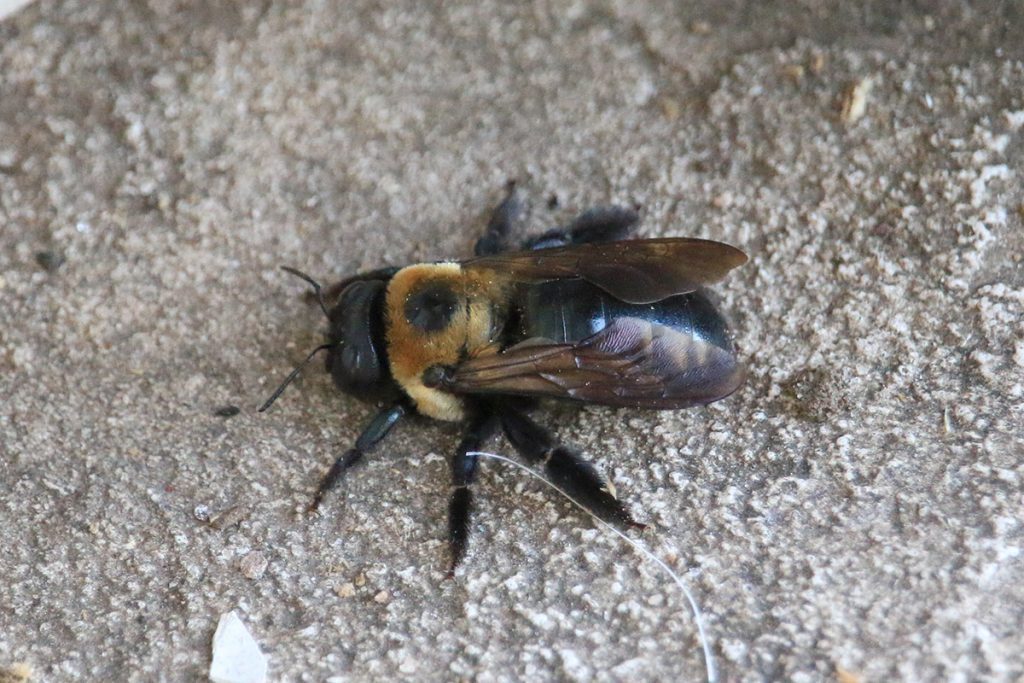

After a while, this bee started moving. It did let me lean in get some close photos, and some point either woke up and left, or was eaten. Reading up on this species, older females usually die by August, when their broods emerge. The older bees sometimes fall to the ground while flying, or will crawl around instead of fly.
This is a species with a wide range, and we’re in the warmer part of that range. I always keep that in mind when I read about species like this one, which is found as far north as Maine and Ontario. Carpenter bees here are likely to be on a different clock than far up north.
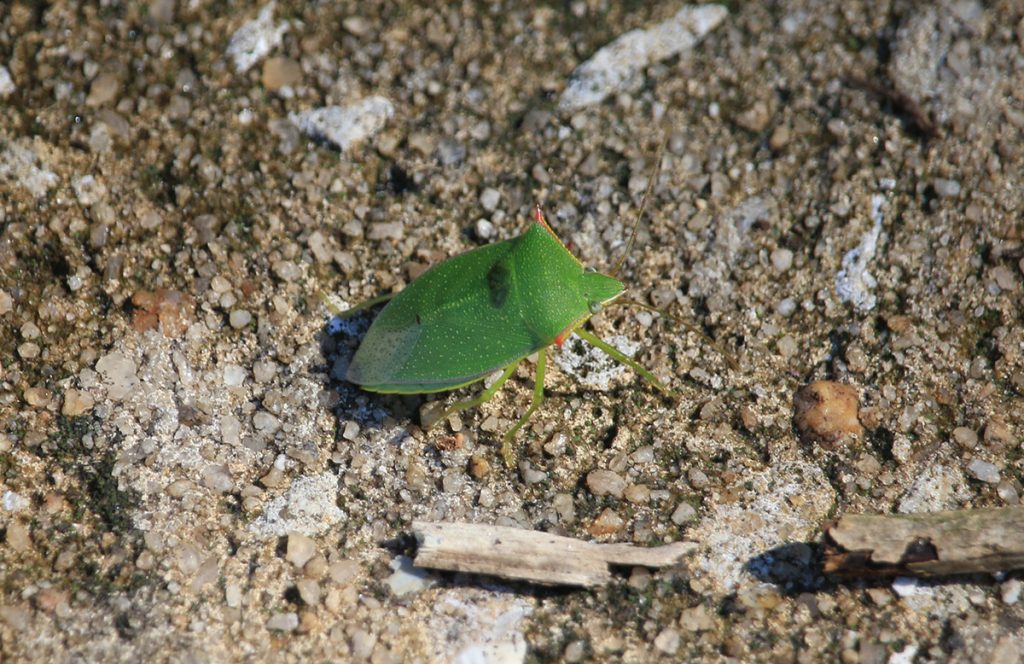

Some of our cherry laurel trees needed trimming. As I gathered the cut branches, I found a couple of different stink bugs. This spined green stink bug was crawling away from the pile.
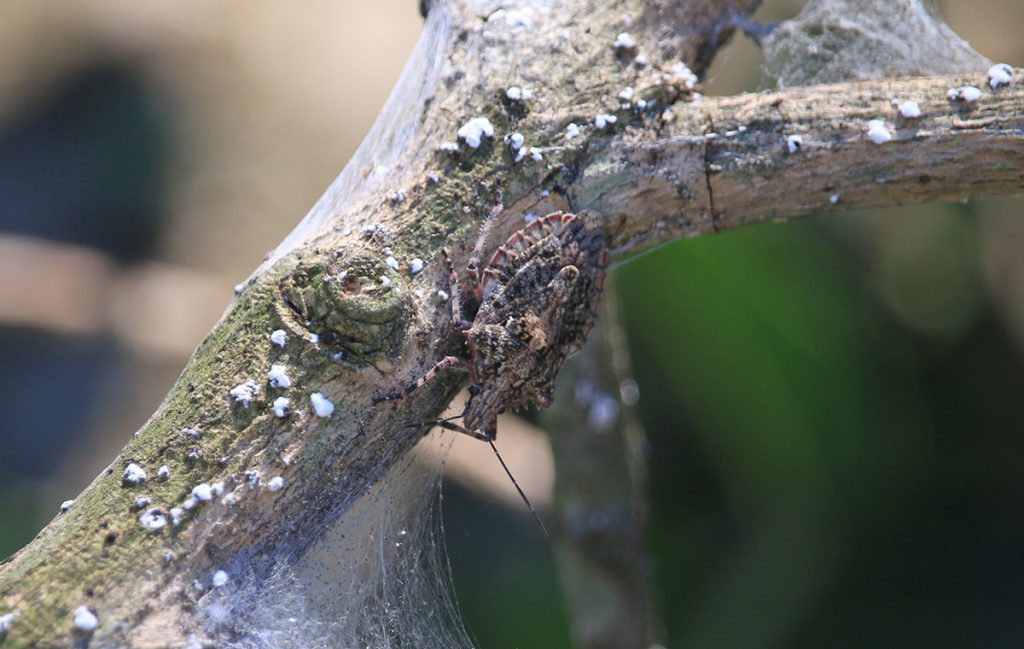

When you’ve evolved to look like the branch, you are perhaps less likely to leave the branch. I’ve seen a few stink bugs like this, and can never get a species specific ID.
I’ve started to notice these trees a little more this year. I’d never noticed how much pollinators loved their flowers before this past May. And I always see different plant eaters on the lower branches. For as many insects as I see at closer to eye level, I know there are many more higher up, or deeper between the leaves.
Wrapping up
As I mentioned earlier, we’re closing in on our third year of the Backyard Blog. It’s been an enjoyable side project on the WFSU Ecology Blog. The longer I do it, and the more diligent I am about taking photos, the better sense I get for seasonal rhythms, and the many relationships between plants and animals. And it’s crazy how many different plants will grow in even a small yard like ours, and how much wildlife makes use of those plants.
I’m already bending my mind towards any changes to the format for 2021. I’m open to suggestions if you have any.
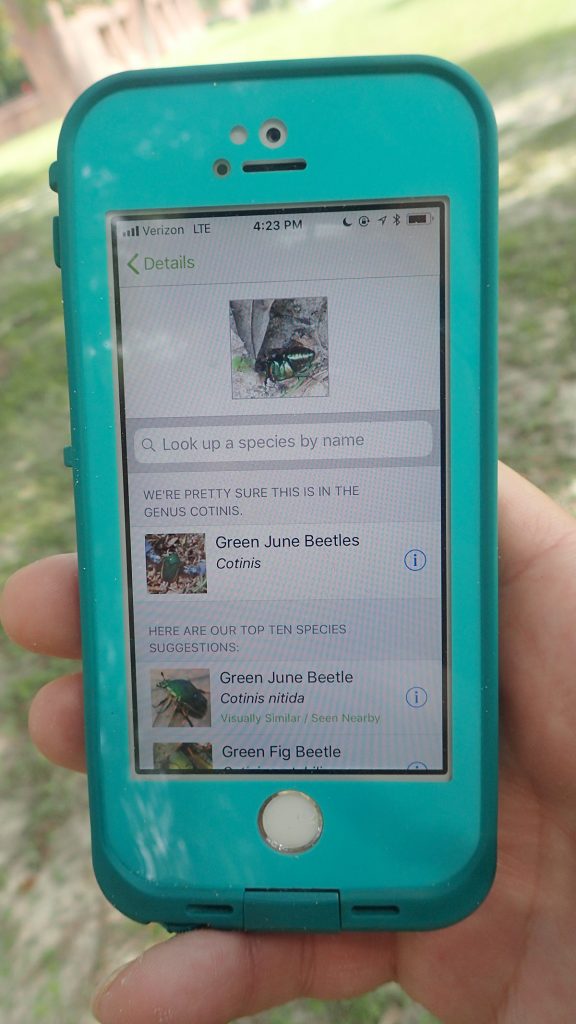

Apps and Citizen Science mentioned in the Backyard Blog
iNaturalist
Identify plants, animals, lichens, and fungi in your yard. Other users correct your identifications if you’re wrong, and even if they don’t, it can be a good springboard to further research.
Seek by iNaturalist
Instant identification, and it doesn’t record your location. This is a good option for kids with phones.
Monarch Larva Monitoring Project
Enter information about monarch caterpillars in your yard, and help researchers get a sense of the health of the monarch population that year, and how and when they’re migrating.
Great Sunflower Project
Record the number of pollinators visiting your flowers, and help researchers map pollinator activity across the country.



Dig Deeper into Backyard Ecology
What can we do to invite butterflies, birds, and other wildlife into our yards? And what about the flora and fauna that makes its way into our yards; the weeds, insects, and other critters that create the home ecosystem? WFSU Ecology Blog takes a closer look.

